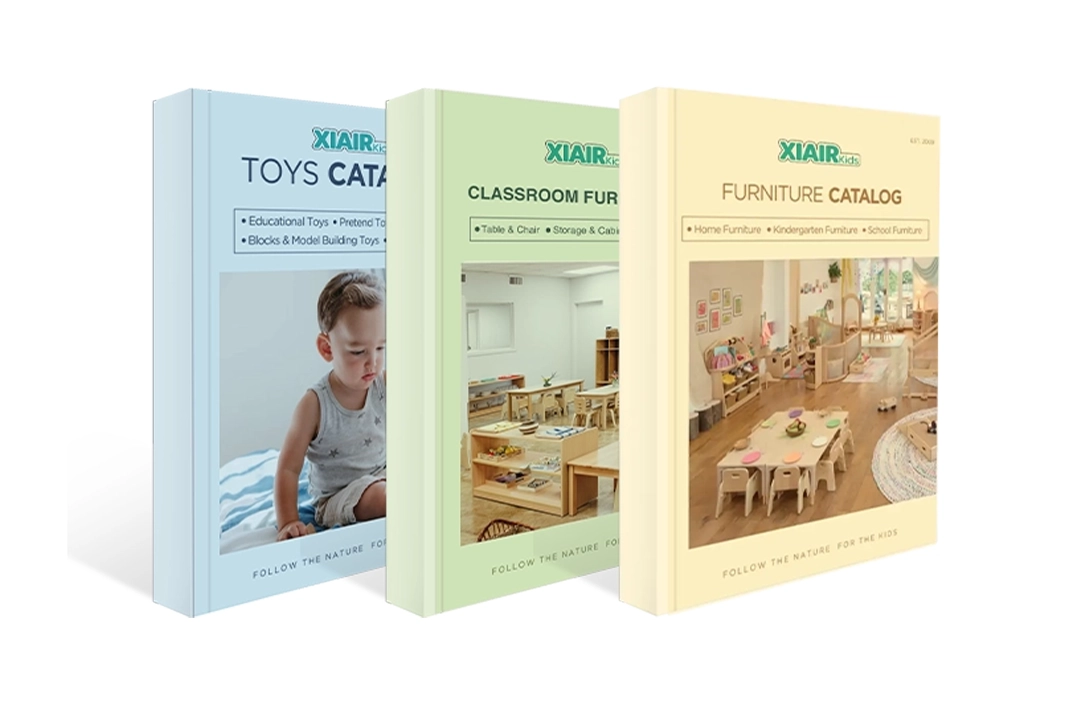การแนะนำ
การสร้างสถานที่ที่ปลอดภัยและเสริมสร้างพัฒนาการสำหรับเด็กก่อนวัยเรียนไม่ใช่เรื่องง่ายเสมอไป โดยเฉพาะในร่ม ศูนย์เด็กเล็กหลายแห่งมีพื้นที่กลางแจ้งจำกัด สภาพอากาศไม่แน่นอน หรือมีกฎความปลอดภัยที่เข้มงวดซึ่งทำให้การเล่นกลางแจ้งเป็นเรื่องท้าทาย แต่แม้แต่ในห้องเรียนเด็กก่อนวัยเรียนที่มีขนาดเล็กที่สุด ความจำเป็นในการเคลื่อนไหวและการเล่นก็ไม่เคยหายไป
เมื่อเด็กไม่มีโอกาสได้ปลดปล่อยพลังงานหรือสำรวจผ่านกิจกรรมทางกาย การกระทำดังกล่าวไม่เพียงแต่ส่งผลต่ออารมณ์เท่านั้น ครูมักจะสังเกตเห็นว่าห้องเรียนมีสิ่งรบกวนมากขึ้น สมาธิสั้นลง และโอกาสในการเรียนรู้ทางสังคมน้อยลง เด็กๆ จะพลาดช่วงเวลาสำคัญที่สนับสนุนการเติบโตของพวกเขาโดยไม่มีพื้นที่ที่เหมาะสมสำหรับการปีนป่าย คลาน หรือแกล้งทำ
การเล่นในร่มสามารถช่วยแก้ปัญหาทั้งหมดนี้ได้ แต่ไม่ใช่ว่าพื้นที่ในร่มทุกแห่งจะสามารถทำได้ การวางของเล่นไว้ตามมุมห้องหรือเสื่อนุ่มๆ บนพื้นอาจทำให้เด็กๆ เพลิดเพลินได้ แต่ของเล่นเหล่านี้จะไม่ช่วยสนับสนุนการพัฒนาทางร่างกาย สังคม และสติปัญญาของเด็กก่อนวัยเรียนได้อย่างเต็มที่ วิธีแก้ปัญหาที่แท้จริงคือสนามเด็กเล่นในร่มก่อนวัยเรียนที่ได้รับการออกแบบอย่างพิถีพิถัน ซึ่งส่งเสริมการเล่นที่กระตือรือร้น รองรับเป้าหมายการเรียนรู้ และให้เด็กๆ ได้สำรวจอย่างปลอดภัย
คู่มือนี้จะแสดงให้คุณเห็นถึงวิธีการสร้างพื้นที่เล่นในร่มที่เหมาะกับโรงเรียนอนุบาลของคุณ ไม่ว่าคุณจะมีห้องเรียนเพียงห้องเดียวหรือศูนย์รวมทั้งหมด เราจะกล่าวถึงวิธีการวางแผนเค้าโครง เลือกอุปกรณ์ที่เหมาะสม ออกแบบสำหรับกลุ่มอายุต่างๆ อยู่ในงบประมาณ และปฏิบัติตามมาตรฐานความปลอดภัย ด้วยแนวทางที่ถูกต้อง แม้แต่สนามเด็กเล่นในร่มขนาดเล็กก็สามารถส่งผลต่อประสบการณ์ในแต่ละวันของเด็กก่อนวัยเรียนของคุณได้อย่างมาก

เหตุใดสนามเด็กเล่นในร่มจึงมีความสำคัญต่อโรงเรียนอนุบาลสมัยใหม่
โรงเรียนอนุบาลเป็นมากกว่าห้องเรียน แต่เป็นพื้นที่ที่เด็กๆ เรียนรู้ผ่านการเคลื่อนไหว การเล่น และประสบการณ์ในแต่ละวัน การสร้างสภาพแวดล้อมทางกายภาพที่เหมาะสมจึงมีความจำเป็น เนื่องจากช่วงปีแรกๆ เป็นช่วงสำคัญในการพัฒนาทักษะการเคลื่อนไหว การรับรู้ทางอารมณ์ และพฤติกรรมทางสังคม
สนามเด็กเล่นในร่มช่วยให้เด็กๆ ได้สำรวจและเคลื่อนไหวร่างกายได้โดยไม่คำนึงถึงสภาพอากาศหรือสถานที่ ในโรงเรียนอนุบาลสมัยใหม่ โดยเฉพาะในเขตเมืองหรืออาคารหลายชั้น การเข้าถึงพื้นที่กลางแจ้งอาจจำกัดหรือไม่สามารถเข้าถึงได้ สนามเด็กเล่นในร่มช่วยให้กิจกรรมทางกายเป็นส่วนหนึ่งของวันเรียนตามปกติโดยไม่ถูกรบกวนจากปัจจัยภายนอก
ที่สำคัญกว่านั้น สนามเด็กเล่นในร่มยังช่วยให้ออกแบบได้อย่างมีโครงสร้างอีกด้วย พื้นที่ทุกส่วนสามารถสร้างขึ้นให้เหมาะกับความต้องการพัฒนาการของเด็กก่อนวัยเรียนได้ ตั้งแต่องค์ประกอบของสนามเด็กเล่นในร่มที่นุ่มสบายซึ่งช่วยสนับสนุนการปีนป่ายและคลานอย่างปลอดภัยไปจนถึงแผงโต้ตอบที่ช่วยฝึกทักษะการเคลื่อนไหวของกล้ามเนื้อมัดเล็ก ทุกส่วนของสภาพแวดล้อมสามารถออกแบบขึ้นอย่างตั้งใจเพื่อรองรับการเรียนรู้ของเด็กทั้งตัว
พื้นที่เหล่านี้ยังช่วยเสริมสร้างแนวทางการศึกษา เช่น มอนเตสซอรี หรือเรจจิโอเอมีเลีย ซึ่งมองว่าสภาพแวดล้อมเป็น "ครูคนที่สาม" ด้วยการจัดสถานที่ที่เหมาะสม สนามเด็กเล่นในร่มสามารถรองรับการสำรวจแบบเปิดกว้าง การทำงานร่วมกันเป็นกลุ่ม และการคิดอย่างอิสระ ซึ่งล้วนเป็นเป้าหมายสำคัญในโปรแกรมการเรียนรู้ช่วงต้นในปัจจุบัน
โดยสรุปแล้ว สนามเด็กเล่นในร่มสำหรับเด็กก่อนวัยเรียนนั้นไม่เพียงแต่เป็นความสะดวกสบายเท่านั้น แต่ยังเป็นส่วนสำคัญของพื้นที่การเรียนรู้สมัยใหม่ที่ช่วยสนับสนุนพัฒนาการทางกายภาพ เสริมเป้าหมายด้านการศึกษา และรับรองว่าสามารถเล่นได้ตลอดเวลา ไม่ว่าจะเป็นฤดูกาลใด
ความท้าทายในชีวิตจริง: สภาพอากาศ พื้นที่ ความปลอดภัย และความต้องการในการเรียนรู้
แม้ว่าจะมีความตั้งใจดี แต่โรงเรียนอนุบาลหลายแห่งก็ยังต้องเผชิญกับอุปสรรคในการจัดกิจกรรมทางกายประจำวัน สภาพอากาศที่ไม่แน่นอนเป็นปัญหาที่น่ากังวลอยู่เสมอ โดยเฉพาะในภูมิภาคที่มีฤดูหนาวยาวนาน ฝนตกหนัก หรือคุณภาพอากาศไม่ดี แม้แต่โรงเรียนที่มีพื้นที่เล่นกลางแจ้งก็มักจะถูกปิดกั้นเป็นเวลาหลายวันหรือหลายสัปดาห์
ความท้าทายอีกอย่างคือพื้นที่ โรงเรียนอนุบาลไม่ได้มีสนามเด็กเล่นกลางแจ้งทั้งหมด บางแห่งตั้งอยู่ในอาคารที่ไม่ได้ออกแบบมาสำหรับเด็กโดยเฉพาะ เช่น สำนักงาน อพาร์ตเมนต์ หรือพื้นที่ขายปลีกที่ดัดแปลงมา สภาพแวดล้อมเหล่านี้ทำให้การจัดกิจกรรมการเล่นที่เด็กต้องการเป็นเรื่องท้าทาย แม้แต่สนามเด็กเล่นในร่มขนาดเล็กสำหรับเด็กเล็กหรือห้องเล่นอเนกประสงค์ก็มีความสำคัญในกรณีเช่นนี้
ความกังวลด้านความปลอดภัยและสุขอนามัยก็เพิ่มมากขึ้นเช่นกัน เนื่องจากมีการให้ความสำคัญกับการป้องกันการบาดเจ็บ พื้นผิวที่ทำความสะอาดได้ และอุปกรณ์ที่เหมาะสมกับวัยมากขึ้น สนามเด็กเล่นในร่มจึงสามารถควบคุมได้มากขึ้น ปัจจุบันโรงเรียนอนุบาลหลายแห่งต้องการอุปกรณ์สนามเด็กเล่นในร่มที่นุ่มและทำความสะอาดง่าย ซึ่งออกแบบมาโดยเฉพาะสำหรับเด็กอายุ 2 ถึง 6 ขวบ
นอกเหนือจากการจัดการด้านโลจิสติกส์แล้ว ความต้องการผลลัพธ์จากการเรียนรู้ยังเปลี่ยนวิธีคิดของเราเกี่ยวกับการเล่นอีกด้วย การเคลื่อนไหวและการเล่นคาดว่าจะช่วยสนับสนุนพัฒนาการทางปัญญา อารมณ์ และสังคม ไม่ใช่แค่สุขภาพกายเท่านั้น ครูและผู้อำนวยการโครงการมองหาการออกแบบสนามเด็กเล่นที่ผสมผสานการสำรวจทางประสาทสัมผัส การเล่นตามจินตนาการ และการโต้ตอบกับเพื่อนฝูงเข้ากับกิจวัตรประจำวัน
ความท้าทายเหล่านี้ไม่เพียงแต่เป็นเรื่องเชิงปฏิบัติเท่านั้น แต่ยังให้ความรู้ด้วย สำหรับโรงเรียนหลายแห่ง สนามเด็กเล่นในร่มที่ออกแบบมาอย่างดีจะช่วยให้ตอบสนองได้ชัดเจน ยืดหยุ่น และมีประสิทธิภาพสูง
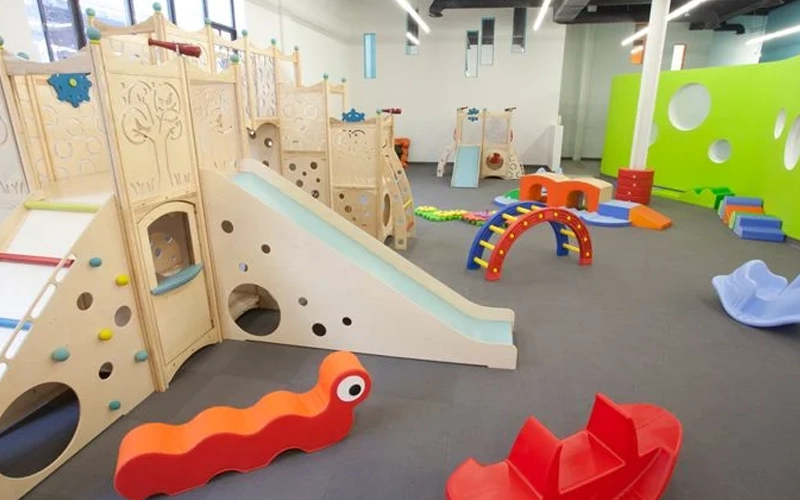

ทำความเข้าใจความต้องการของเด็กก่อนวัยเรียนในสนามเด็กเล่นในร่ม
การออกแบบสนามเด็กเล่นในร่มสำหรับเด็กก่อนวัยเรียนไม่ได้หมายความถึงการเลือกอุปกรณ์ที่มีสีสันหรือการเติมเต็มห้องว่างๆ เท่านั้น แต่จะต้องเริ่มต้นด้วยการทำความเข้าใจว่าเด็กก่อนวัยเรียนเติบโต เคลื่อนไหว และเรียนรู้อย่างไร เด็กอายุระหว่าง 2 ถึง 6 ขวบอยู่ในช่วงพัฒนาการที่แตกต่างกัน และสนามเด็กเล่นในร่มที่ออกแบบมาอย่างดีควรสะท้อนถึงความต้องการทางกายภาพ อารมณ์ ความคิด และสังคมของพวกเขา
ความต้องการการเจริญเติบโตทางร่างกายและการเคลื่อนไหว
ในวัยนี้ เด็กๆ จะพัฒนาทักษะการเคลื่อนไหวร่างกายโดยรวมอย่างรวดเร็ว ไม่ว่าจะเป็นการทรงตัว การประสานงาน การปีนป่าย การคลาน และการกระโดด สนามเด็กเล่นในร่มสำหรับเด็กก่อนวัยเรียนเป็นสภาพแวดล้อมที่ปลอดภัยสำหรับเด็กๆ ในการฝึกฝนทักษะเหล่านี้โดยธรรมชาติและไม่ต้องวางแผนล่วงหน้า สิ่งอำนวยความสะดวกต่างๆ เช่น ทางลาดสำหรับปีนป่ายแบบนิ่ม สไลเดอร์ขนาดเล็ก อุโมงค์ และพื้นที่เปิดโล่ง จะช่วยส่งเสริมให้เด็กๆ เคลื่อนไหวร่างกายได้เต็มที่โดยไม่ทำให้ความสามารถของเด็กๆ มากเกินไป
การพัฒนากล้ามเนื้ออย่างกว้างขวางมีความเกี่ยวข้องอย่างใกล้ชิดกับความมั่นใจและการทำงานของสมอง โดยเฉพาะสำหรับเด็กวัยเตาะแตะ พื้นที่ที่อนุญาตให้คลาน ดึงตัวขึ้น หรือปีนป่ายเบาๆ เช่น พื้นที่สนามเด็กเล่นในร่มสำหรับเด็กเล็กหรือ สนามเด็กเล่นที่อ่อนนุ่ม—ช่วยสร้าง ความแข็งแรงทางกายและความเป็นอิสระ กิจกรรมเหล่านี้ยังสนับสนุนการพัฒนาระบบการทรงตัวและการรับรู้ตำแหน่งของร่างกาย ซึ่งเป็นสิ่งสำคัญสำหรับการทรงตัวและการรับรู้ร่างกาย
การพัฒนาความรู้ความเข้าใจและความคิดสร้างสรรค์
เด็กก่อนวัยเรียนยังได้สำรวจโลกผ่านจินตนาการและการเล่น สนามเด็กเล่นในร่มที่มีสถานีเล่นจำลอง แผงสัมผัส หรือวัสดุปลายเปิด ช่วยให้เด็กๆ คิดสร้างสรรค์และแก้ปัญหาผ่านการลองผิดลองถูก มุมเล่นตามบทบาท บล็อกตัวต่อ และโซนตามธีมต่างๆ จะช่วยกระตุ้นให้เด็กๆ สร้างเรื่องราวและนำทางพลวัตทางสังคม
การเล่นประเภทนี้ไม่เพียงแต่สนุกสนานเท่านั้น แต่ยังช่วยพัฒนาความจำ การใช้เหตุผล สมาธิ และทักษะทางคณิตศาสตร์และภาษาเบื้องต้นด้วย ตัวอย่างเช่น ตลาดจำลองอาจเกี่ยวข้องกับการนับสิ่งของ การผลัดกันเล่น หรือการเรียกชื่อสีและรูปร่าง โครงสร้างปีนป่ายแบบนิ่มที่มีตัวเลขพิมพ์อยู่บนขั้นบันไดสามารถผสมผสานการเคลื่อนไหวเข้ากับการเรียนรู้ด้วยภาพได้ เมื่อออกแบบอย่างดี สนามเด็กเล่นในร่มจะกลายเป็นส่วนขยายตามธรรมชาติของสภาพแวดล้อมการเรียนรู้
ความต้องการทางอารมณ์และสังคม
เด็กๆ ยังได้เรียนรู้ที่จะจัดการอารมณ์ สร้างมิตรภาพ และเข้าใจผู้อื่นอีกด้วย สนามเด็กเล่นในร่มสำหรับเด็กก่อนวัยเรียนที่มีโซนกิจกรรมกลุ่มเล็กหรือองค์ประกอบการทำงานร่วมกันสามารถสร้างโอกาสในการแบ่งปัน ผลัดกันเล่น และแสดงความเห็นอกเห็นใจผู้อื่นได้
ในขณะเดียวกัน พื้นที่ควรให้เด็กๆ ได้เล่นคนเดียวหรือเล่นอย่างเงียบๆ ไม่ใช่เด็กทุกคนที่ต้องการมีปฏิสัมพันธ์ที่เสียงดังและกระตือรือร้นตลอดเวลา มุมสบายๆ มุมอ่านหนังสือ หรือกิจกรรมสัมผัสส่วนบุคคลจะช่วยให้ควบคุมอารมณ์ได้ และให้เด็กๆ ได้มีวิธีที่ปลอดภัยในการประมวลผลความรู้สึกของตนเอง
สนามเด็กเล่นที่สมดุลจะช่วยให้ผู้เรียนทุกคนมีพื้นที่ในการเจริญเติบโต ไม่ว่าจะร่าเริงหรือสงวนตัว กระตือรือร้นหรือระมัดระวัง
ความปลอดภัยและความสามารถในการคาดการณ์
ความต้องการที่มักถูกมองข้ามในวัยนี้ก็คือความสามารถในการคาดเดาได้ เด็กก่อนวัยเรียนจะเติบโตได้ดีในสภาพแวดล้อมที่พวกเขารู้ว่าจะคาดหวังอะไรได้บ้าง สนามเด็กเล่นในร่มที่มีการแบ่งโซน มีรูปแบบที่สม่ำเสมอ และมีกิจวัตรที่คุ้นเคย ช่วยลดความวิตกกังวลและทำให้การเล่นมีความหมายมากขึ้น อุปกรณ์ที่มีความเสี่ยงต่ำ พื้นนุ่ม และการออกแบบภายใต้การดูแลช่วยสร้างความรู้สึกปลอดภัยที่ให้เด็กๆ ได้สำรวจอย่างอิสระโดยไม่ต้องกลัว
ไม่ว่าจะเป็นการคลานผ่านอุโมงค์ ต่อบล็อกโฟม หรือแกล้งทำเป็นทำอาหารกับเพื่อนๆ กิจกรรมต่างๆ ในสนามเด็กเล่นในร่มนั้นไม่เพียงแต่สนุกสนานเท่านั้น แต่ยังเป็นรากฐานของชีวิตอีกด้วย โดยการออกแบบพื้นที่โดยคำนึงถึงช่วงพัฒนาการของเด็กๆ บุคลากรของโรงเรียนอนุบาลสามารถสร้างสภาพแวดล้อมที่รองรับทุกแง่มุมของการเติบโตในวัยเด็กตอนต้นได้


พื้นที่ขั้นต่ำที่จำเป็นสำหรับสนามเด็กเล่นในร่มของโรงเรียนอนุบาลคือเท่าใด?
ความกังวลที่พบบ่อยที่สุดประการหนึ่งที่ผู้ดูแลโรงเรียนอนุบาลต้องเผชิญเมื่อวางแผนสร้างสนามเด็กเล่นในร่มคือเรื่องพื้นที่ ไม่ใช่โรงเรียนอนุบาลทุกแห่งที่จะมีพื้นที่เปิดโล่งขนาดใหญ่ บางแห่งดำเนินการในห้องเรียนเดี่ยว อพาร์ตเมนต์ดัดแปลง หรืออาคารอเนกประสงค์ แต่พื้นที่จำกัดไม่ได้หมายความว่าจะมีการเล่นที่จำกัด ด้วยการวางแผนอย่างรอบคอบ แม้แต่โรงเรียนขนาดเล็กก็สามารถสร้างสนามเด็กเล่นในร่มที่ปลอดภัย มีประโยชน์ใช้สอย และส่งเสริมพัฒนาการได้
พื้นที่ที่แนะนำต่อเด็ก
แม้ว่าจะไม่มีกฎเกณฑ์ตายตัว แต่ผู้เชี่ยวชาญส่วนใหญ่แนะนำให้จัดสรรพื้นที่เล่นในร่ม 1.5 ถึง 2.5 ตารางเมตรต่อเด็ก วิธีนี้จะช่วยให้มั่นใจได้ว่าเด็ก ๆ จะมีพื้นที่เพียงพอในการเคลื่อนไหวอย่างอิสระโดยไม่ชนกันหรือชนอุปกรณ์ จำนวนที่แน่นอนขึ้นอยู่กับกลุ่มอายุและวิธีการใช้พื้นที่:
- เด็กวัยเตาะแตะ (1–2 ปี): ประมาณ 1.5 ตรม. ต่อเด็ก
- เด็กก่อนวัยเรียน (3–4 ปี): ประมาณ 2 ตรม. ต่อเด็ก
- เด็กก่อนวัยเรียนตอนโต (5–6 ปี): สูงสุด 2.5 ตรม. ต่อเด็ก
นอกจากนี้ จำเป็นต้องพิจารณาถึงพื้นที่สัญจร — พื้นที่ที่เด็กต้องใช้เพื่อเดินหรือวิ่งอย่างปลอดภัยระหว่างโซนต่างๆ — และบริเวณที่ผู้ใหญ่ดูแลด้วย
การออกแบบสำหรับพื้นที่ขนาดเล็กและที่ใช้ร่วมกัน
โรงเรียนอนุบาลหลายแห่งต้องใช้พื้นที่เล่นในร่มร่วมกับสถานที่อื่นๆ เช่น ห้องเรียน พื้นที่นอนกลางวัน หรือห้องกิจกรรม ในสถานการณ์เช่นนี้ อุปกรณ์สนามเด็กเล่นในร่มของโรงเรียนอนุบาลจะต้องมีขนาดกะทัดรัด ปรับเปลี่ยนได้ง่าย กระดานสัมผัสติดผนัง เสื่อนุ่มพับได้ และหน่วยปีนป่ายมุมห้อง ล้วนเป็นตัวเลือกการเล่นที่น่าสนใจโดยไม่ต้องใช้พื้นที่ห้องทั้งหมด
การจัดการเล่นแบบยืดหยุ่นช่วยให้โรงเรียนสามารถรักษาความปลอดภัยและเป้าหมายการพัฒนาในขณะที่ทำงานภายใน พื้นที่ของพวกเขา ด้วยอุปกรณ์และเลย์เอาต์ที่เหมาะสม แม้แต่มุมเล็กๆ ก็สามารถกลายเป็นห้องเล่นในร่มที่ใช้งานได้จริง.
การสร้างสมดุลระหว่างพื้นที่เล่นแบบเปิดโล่งและพื้นที่เล่นแบบมีโครงสร้าง
สนามเด็กเล่นในร่มที่มีประสิทธิภาพสำหรับเด็กก่อนวัยเรียนประกอบด้วยพื้นที่เปิดโล่งสำหรับการเคลื่อนไหวอิสระและโซนที่มีโครงสร้างพร้อมฟังก์ชันเฉพาะ พื้นที่เปิดโล่งช่วยให้เด็กๆ วิ่ง เต้นรำ หรือเล่นเกมได้ ในขณะที่โซนที่กำหนดไว้ เช่น ครัวจำลองหรือผนังสัมผัสจะช่วยให้มีกิจกรรมที่เน้นสมาธิ
หากต้องการใช้พื้นที่จำกัดให้เกิดประโยชน์สูงสุด ควรพิจารณาใช้แนวทางการออกแบบแบบหลายชั้น:
- ใช้อุปกรณ์ปีนป่ายแบบนุ่มที่ทำหน้าที่เป็นที่นั่งได้ด้วย
- รวมแผงเล่นเข้ากับผนังหรือเฟอร์นิเจอร์
- เลือกสิ่งของที่วางซ้อนกันได้หรือเคลื่อนย้ายได้ที่สามารถหมุนเวียนได้ตลอดสัปดาห์
การจัดวางที่ดีไม่ได้ขึ้นอยู่กับว่าคุณมีพื้นที่มากเพียงใด แต่ขึ้นอยู่กับว่าคุณใช้พื้นที่นั้นอย่างไร ด้วยการเลือกการออกแบบที่ถูกต้อง สนามเด็กเล่นในร่มขนาดเล็กก็สามารถรองรับเป้าหมายการพัฒนาได้เท่ากับสนามเด็กเล่นขนาดใหญ่กว่ามาก
การวางผังเค้าโครง: การใช้พื้นที่ในร่มให้เกิดประโยชน์สูงสุด
การออกแบบ แผนผังของโรงเรียนอนุบาล สนามเด็กเล่นในร่มไม่ได้หมายความถึงแค่สถานที่เท่านั้น แต่ยังหมายถึงการสร้างพื้นที่ที่คล่องตัว รู้สึกเปิดโล่ง และรองรับการเคลื่อนไหวที่ปลอดภัยและมีจุดมุ่งหมาย ต่อไปนี้คือหลักการจัดวาง 5 ประการที่ช่วยให้ใช้พื้นที่ในร่มได้คุ้มค่าที่สุด ไม่ว่าจะมีขนาดใหญ่หรือเล็กก็ตาม
- แยกโซนกิจกรรมและโซนเงียบ
จัดกลุ่มอุปกรณ์การเล่นทางกายภาพ เช่น อุปกรณ์ปีนป่ายและอุโมงค์ ไว้ในพื้นที่เดียวกัน และจัดพื้นที่เงียบๆ เช่น มุมอ่านหนังสือหรือผนังสัมผัสไว้ฝั่งตรงข้าม วิธีนี้จะช่วยลดเสียงรบกวนและทำให้เด็กๆ สามารถเลือกประเภทของการเล่นที่ต้องการได้
- รักษาทางเดินให้โล่ง
หลีกเลี่ยงการวางอุปกรณ์ไว้ใกล้กันเกินไป ให้แน่ใจว่าเด็กๆ สามารถเคลื่อนที่จากส่วนหนึ่งของห้องไปยังอีกส่วนหนึ่งได้อย่างปลอดภัย ทางเดินที่เปิดโล่งเพียงไม่กี่แห่งสามารถป้องกันอุบัติเหตุได้ และทำให้ครูมองเห็นได้ชัดเจนยิ่งขึ้นแม้ในพื้นที่แคบ
- ใช้อุปกรณ์แบบโมดูลาร์และเคลื่อนย้ายได้
เลือกสิ่งของที่สามารถเคลื่อนย้ายหรือปรับเปลี่ยนรูปแบบได้ตามต้องการ บล็อกโฟมแบบวางซ้อนกันได้ อุโมงค์น้ำหนักเบา และเสื่อพับได้ ช่วยให้คุณปรับเปลี่ยนรูปแบบได้ตามขนาดของกลุ่มหรือกิจกรรม วิธีนี้เหมาะเป็นอย่างยิ่งสำหรับห้องสนามเด็กเล่นในร่มที่ใช้ทำกิจกรรมต่างๆ ในชีวิตประจำวัน
- ใช้ประโยชน์จากพื้นที่แนวตั้ง
หากพื้นที่จำกัด ให้ย้ายขึ้นไปชั้นบน กระดานสัมผัสติดผนัง ที่จับปีนป่าย หรือช่องเก็บของแนวตั้งสามารถเพิ่มมูลค่าได้โดยไม่ทำให้ห้องรก การเล่นแนวตั้งยังเพิ่มความท้าทายทางกายภาพประเภทอื่นให้กับเด็กก่อนวัยเรียนอีกด้วย
- รักษาการมองเห็นและความสบาย
ครูควรสามารถมองเห็นเด็กๆ ทุกคนได้ตลอดเวลา หลีกเลี่ยงการใช้ฉากกั้นที่สูงหรืออุปกรณ์ปิดที่ปิดกั้นทัศนียภาพ ใช้พื้นที่นุ่ม แสงไฟโทนอุ่น และโซนสีที่ให้ความรู้สึกสงบเพื่อให้พื้นที่รู้สึกปลอดภัย อบอุ่น และน่าอยู่
ด้วยแผนผังเค้าโครงที่ชัดเจน แม้แต่โรงเรียนอนุบาลแบบกะทัดรัดก็สามารถรองรับการเล่นที่กระตือรือร้น ปลอดภัย และมีคุณค่าในแต่ละวันได้ โดยไม่จำเป็นต้องมีห้องออกกำลังกายขนาดใหญ่หรือห้องเล่นเฉพาะ


โซนการใช้งานที่สำคัญในสนามเด็กเล่นในร่มของโรงเรียนอนุบาล
สนามเด็กเล่นในร่มที่มีประสิทธิภาพสำหรับเด็กก่อนวัยเรียนไม่ได้เป็นเพียงห้องที่มีของเล่นเท่านั้น แต่ยังเป็นพื้นที่ที่ได้รับการออกแบบอย่างพิถีพิถันโดยแบ่งออกเป็นโซนต่างๆ ซึ่งแต่ละโซนจะรองรับการพัฒนาด้านต่างๆ ของเด็ก โซนที่ใช้งานได้จริงเหล่านี้จะช่วยให้เด็กก่อนวัยเรียนได้สำรวจ เรียนรู้ และเติบโตอย่างเป็นธรรมชาติและมีส่วนร่วม ต่อไปนี้คือพื้นที่ที่สำคัญที่สุดที่ควรมีไว้ในเค้าโครงของคุณ
โซนกล้ามเนื้อมัดใหญ่
โซนกล้ามเนื้อมัดใหญ่เป็นส่วนที่มีการเคลื่อนไหวร่างกายมากที่สุดในสนามเด็กเล่นในร่มของโรงเรียนอนุบาล โซนนี้เป็นสถานที่ที่เด็กๆ เสริมสร้างความแข็งแรง สมดุล และการประสานงานผ่านการเคลื่อนไหว ทักษะการเคลื่อนไหวร่างกายเป็นสิ่งสำคัญสำหรับกิจกรรมประจำวัน เช่น การเดิน การวิ่ง การนั่งตัวตรง และการขึ้นบันได ซึ่งเป็นทักษะที่เด็กๆ พัฒนาได้อย่างรวดเร็วเมื่ออายุระหว่าง 2 ถึง 6 ขวบ
ในโซนนี้ อุปกรณ์สนามเด็กเล่นในร่มแบบนิ่ม เช่น ทางลาดโฟม โครงสร้างปีนป่ายขนาดเล็ก อุโมงค์คลาน และหินก้าว ถือเป็นอุปกรณ์ที่เหมาะสม สำหรับเด็กก่อนวัยเรียนที่โตกว่า คุณอาจใช้คานทรงตัว บาร์ลิงที่ปรับขนาดให้เหมาะกับเด็ก หรือสนามเด็กเล่นในร่มแบบจังเกิ้ลยิมที่มีความสูงต่ำและพื้นนุ่ม
การจัดวางโซนนี้เป็นสิ่งสำคัญ โปรดจัดวางไว้ด้านใดด้านหนึ่งของห้อง โดยควรปูพื้นด้วยวัสดุกันกระแทก ห่างจากบริเวณที่เงียบเพื่อหลีกเลี่ยงการรบกวนจากเสียงและการเคลื่อนไหว นอกจากนี้ ควรจัดวางไว้ในตำแหน่งที่โดดเด่นเพื่อให้ครูสามารถดูแลกิจกรรมทั้งหมดได้อย่างง่ายดาย
เพื่อให้เด็กๆ มีส่วนร่วม ควรหมุนเวียนการจัดวางอุปกรณ์ทุกๆ สองสามสัปดาห์ วิธีนี้จะช่วยให้เด็กๆ ได้รับความท้าทายใหม่ๆ โดยไม่จำเป็นต้องเพิ่มอุปกรณ์ใหม่ นอกจากนี้ คุณยังสามารถเปลี่ยนระดับความยากได้โดยการเปลี่ยนระยะทางระหว่างเส้นทางการทรงตัวหรือจัดเรียงบล็อกปีนป่ายใหม่
โซนเสริมสร้างทักษะการเคลื่อนไหวร่างกายไม่ได้มีไว้เพียงการเล่นเท่านั้น แต่ยังเป็นรากฐานของความมั่นใจทางร่างกาย การเสี่ยงภัยในสภาพแวดล้อมที่ปลอดภัย และการรับรู้ของร่างกายทั้งหมด ซึ่งรองรับทักษะทางวิชาการและการใช้ชีวิตในอนาคต
รวม:
- เครื่องเล่นปีนป่ายในร่มแบบนุ่ม
- ทางลาดและขั้นบันไดโฟม
- คานทรงตัว
- อุโมงค์ลอดผ่าน
- ชุดสนามเด็กเล่นในร่มแบบมินิจังเกิ้ลยิม
- พรมปูพื้นนุ่มเพื่อความปลอดภัย

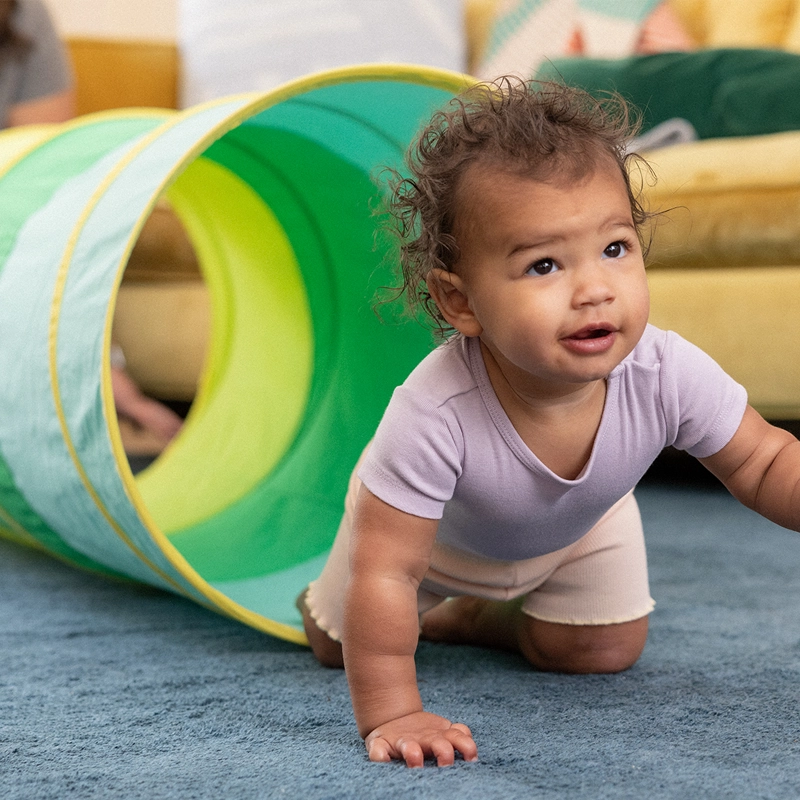

โซนเล่นสัมผัส
โซนสัมผัสคือจุดที่เด็กก่อนวัยเรียนสามารถชะลอความเร็วและใช้ประสาทสัมผัสของตนเองได้ โดยเฉพาะอย่างยิ่งเด็กที่มีความต้องการพิเศษหรือเด็กที่ตื่นตัวมากเกินไปในสภาพแวดล้อมที่มีเสียงดัง
ในส่วนนี้ของสนามเด็กเล่นในร่มสำหรับเด็กวัยเตาะแตะของคุณ ให้เพิ่มองค์ประกอบที่จับต้องได้ เช่น ผนังที่มีพื้นผิว โต๊ะทราย ถังเล่นน้ำ แผงไฟอ่อน หรือเสื่อนุ่มๆ แผงติดผนังที่มีปุ่ม ลูกบิด กระจก หรือวัสดุ เช่น ขนเทียมและยาง ช่วยให้คุณสำรวจได้ไม่รู้จบโดยไม่ต้องใช้พื้นที่บนพื้น ของเล่นที่มีเสียงดนตรีที่มีเสียงนุ่มนวลหรือไฟเปลี่ยนสีสามารถเสริมประสบการณ์ให้สมบูรณ์ยิ่งขึ้น
โซนรับความรู้สึกยังช่วยให้เด็กควบคุมอารมณ์ได้อีกด้วย หากเด็กอารมณ์เสียหรือถูกกระตุ้นมากเกินไป การใช้เวลาสักสองสามนาทีเพื่อกระตุ้นประสาทสัมผัสจะช่วยให้พวกเขาตั้งสติได้ พื้นที่นี้ควรให้ความรู้สึกสงบและน่าอยู่ ใช้แสงธรรมชาติ สีที่ไม่ฉูดฉาด และพื้นผิวที่อ่อนนุ่มเมื่อทำได้
จากมุมมองการออกแบบ โซนนี้เหมาะที่สุดสำหรับบริเวณที่เงียบหรือบริเวณอ่านหนังสือ ควรแยกโซนนี้ออกจากบริเวณที่มีกิจกรรมเคลื่อนไหวร่างกายเล็กน้อย เพื่อให้เด็กๆ สามารถจดจ่อกับกิจกรรมต่างๆ ได้โดยไม่เสียสมาธิ โรงเรียนบางแห่งยังใช้ฉากกั้นหรือเต็นท์เตี้ยเพื่อสร้างพื้นที่กึ่งปิดสำหรับการสำรวจทางประสาทสัมผัสอีกด้วย
การรวมโซนเล่นสัมผัสเข้ากับสนามเด็กเล่นในร่มก่อนวัยเรียนจะช่วยส่งเสริมความยืดหยุ่นทางอารมณ์ ความคิดสร้างสรรค์ และพัฒนาการสำคัญของสมองที่เกี่ยวข้องกับความจำ ความสนใจ และการประมวลผลทางประสาทสัมผัส
รวม:
- แผงสัมผัสแบบติดผนัง
- โต๊ะทรายและน้ำ
- โต๊ะไฟเปลี่ยนสี
- เสื่อนุ่มและพื้นแบบมีพื้นผิว
- ดนตรีเบาๆ และองค์ประกอบเสียงที่เบา
- ถังสัมผัสด้วยวัสดุที่ปลอดภัย

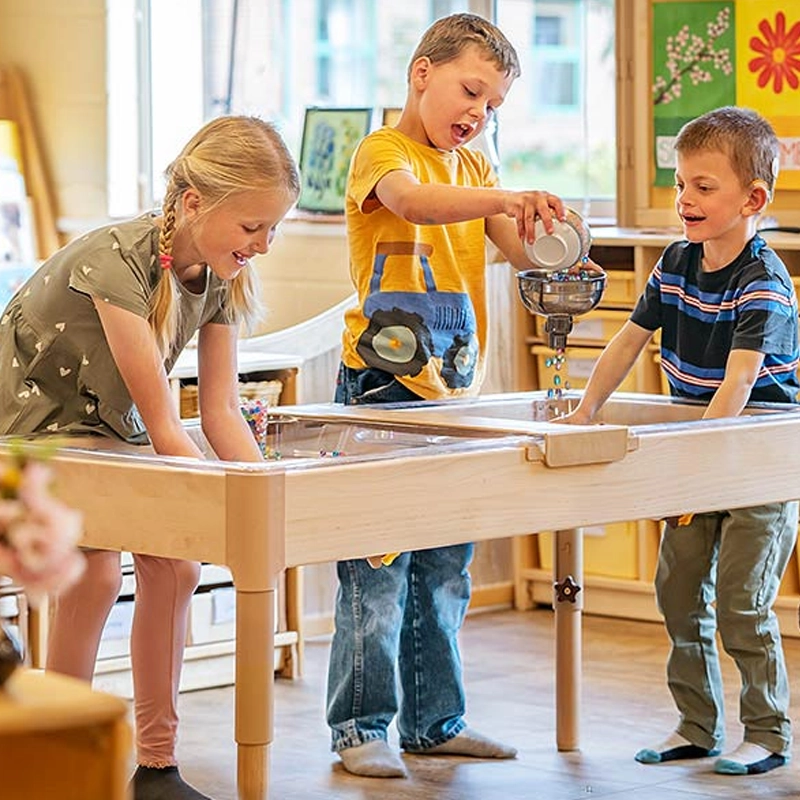

พื้นที่เล่นแกล้งทำ
การเล่นสมมติเป็นส่วนสำคัญของการศึกษาปฐมวัย ช่วยให้เด็กก่อนวัยเรียนเข้าใจโลก แสดงออกในตนเอง และสำรวจบทบาททางสังคมอย่างปลอดภัยและสร้างสรรค์ พื้นที่เล่นสมมติที่มีอุปกรณ์ครบครันจะช่วยส่งเสริมการเติบโตทางปัญญา การรับรู้ทางอารมณ์ และทักษะการสื่อสาร
โซนนี้ประกอบไปด้วยห้องครัวขนาดเล็ก แผงขายของ ชั้นวางเสื้อผ้า โรงละครหุ่นกระบอก และชุดก่อสร้าง ให้เด็กๆ เป็นผู้นำในโซนนี้ วันหนึ่ง พื้นที่แห่งนี้อาจกลายเป็นร้านอาหาร วันต่อมาเป็นโรงพยาบาล และวันต่อมาเป็นยานอวกาศ คุณเพียงแค่จัดเตรียมอุปกรณ์พื้นฐาน และปล่อยให้จินตนาการของพวกเขาเติมเต็มส่วนที่เหลือ
วางโซนนี้ไว้ในมุมห้องหรือตามผนังเพื่อให้เด็กๆ รู้สึกปลอดภัยขณะเล่นบทบาทสมมติ ใช้พรม ผ้าม่าน หรือชั้นวางของเตี้ยๆ เพื่อกำหนดพื้นที่และจัดเก็บวัสดุต่างๆ เก็บของเหล่านี้ไว้อย่างปลอดภัยและเปิดกว้าง ไม่วางสิ่งของที่ถูกกำหนดไว้ล่วงหน้าหรือจำกัดขอบเขตจนเกินไป
พื้นที่เล่นสมมติยังทำหน้าที่เป็นสะพานเชื่อมระหว่างพัฒนาการทางสังคมและอารมณ์กับการเติบโตของภาษา เด็กๆ จะได้เรียนรู้ที่จะแสดงความรู้สึก เจรจาบทบาท เล่าเรื่องราว และทำงานร่วมกับเพื่อนๆ ทักษะชีวิตเหล่านี้จำเป็นที่เริ่มต้นในสนามเด็กเล่นสมมติ
การรวมโซนเล่นบทบาทสมมติไว้โดยเฉพาะจะทำให้สนามเด็กเล่นในร่มสำหรับเด็กก่อนวัยเรียนของคุณมีชีวิตชีวามากขึ้น และรองรับการเรียนรู้แบบองค์รวมผ่านการเล่นแบบเปิดกว้าง
รวม:
- ครัวขนาดเล็กหรือร้านขายของชำ
- มุมแต่งตัวด้วยชุดคอสตูม
- โรงละครหุ่นละครและเวที
- อุปกรณ์การเล่น (อาหาร, ชุดหมอ, เครื่องมือ)
- เฟอร์นิเจอร์เล่นแกล้ง
- ชั้นวางจัดเก็บวัสดุแบบปลายเปิด


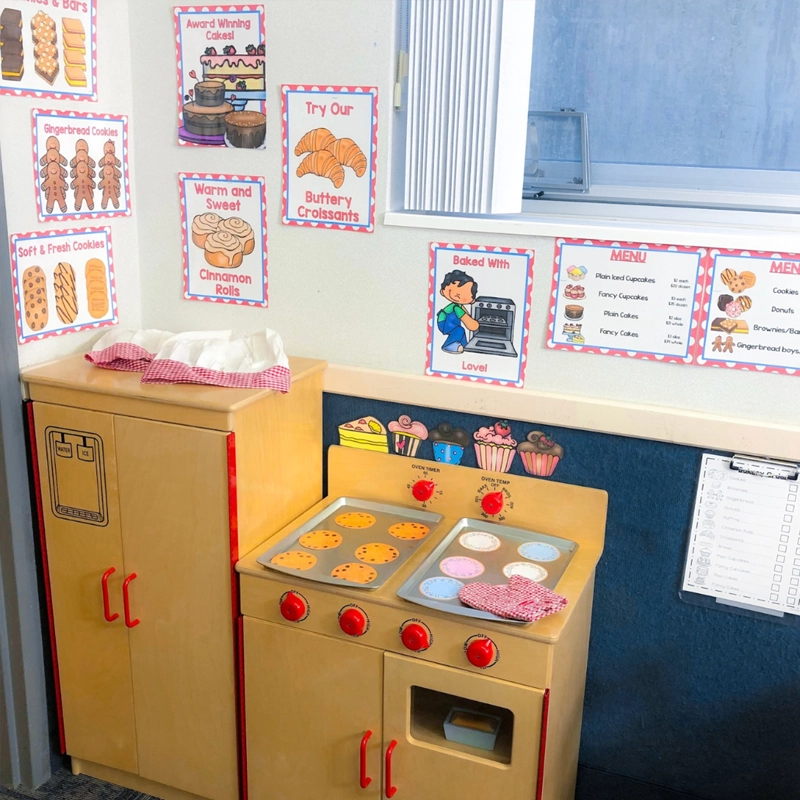
มุมอ่านหนังสือและเงียบสงบ
แม้ว่าการเคลื่อนไหวและการสำรวจจะเป็นสิ่งสำคัญในการเรียนรู้ของเด็กก่อนวัยเรียน แต่เด็กๆ ก็ต้องการเวลาที่จะผ่อนคลายและชาร์จพลังใหม่เช่นกัน การอ่านหนังสือและมุมสงบที่ออกแบบมาอย่างดีจะช่วยให้พวกเขาได้ผ่อนคลาย พักผ่อน หรือทำกิจกรรมคนเดียวอย่างเงียบๆ
พื้นที่นี้มีความสำคัญสำหรับเด็กที่อาจรู้สึกเครียดจากเสียงดังหรือการเล่นเป็นกลุ่ม Quiet Corner เป็นสถานที่สงบและปลอดภัยเพื่อสนับสนุนความเป็นอยู่ที่ดีทางอารมณ์ สมาธิ และการพัฒนาการอ่านเขียนในช่วงเริ่มต้น
โซนนี้ควรอยู่ห่างจากบริเวณที่ใช้การเคลื่อนไหวร่างกายหรือเล่นบทบาทสมมติเพื่อลดเสียงรบกวน เลือกจุดที่อยู่ใกล้หน้าต่างหรือมุมห้องเพื่อส่งสัญญาณการเปลี่ยนแปลงอย่างเป็นธรรมชาติ ใช้แสงไฟนวลๆ วัสดุที่ให้ความรู้สึกอบอุ่น และองค์ประกอบที่คุ้นเคยเพื่อให้พื้นที่ดูน่าดึงดูด
จากมุมมองด้านการศึกษา พื้นที่นี้สนับสนุนการสำรวจด้วยตนเอง เด็กๆ สามารถอ่านหนังสือภาพ เล่านิทาน หรือใช้เวลาสงบๆ สักสองสามนาที พื้นที่นี้ยังมีประโยชน์ในช่วงเปลี่ยนผ่าน ช่วยให้เด็กๆ ผ่อนคลายจากการเล่นที่กระตือรือร้นไปสู่กิจกรรมในห้องเรียนที่เงียบกว่า
มุมอ่านหนังสือยังสามารถเป็นพื้นที่การเรียนรู้ที่ยืดหยุ่นได้ระหว่างการเรียนแบบกลุ่มเล็กหรือแบบตัวต่อตัวอีกด้วย
รวม:
- ชั้นวางหนังสือเตี้ยๆ พร้อมหนังสือที่เหมาะกับวัย
- บีนแบ็ก, เบาะรองนั่ง หรือพรมนุ่มๆ
- พรมปูพื้นลายสงบเงียบ
- หนังสือภาพ การ์ดเรื่องราว และหุ่นกระบอก
- แสงไฟนุ่มนวล (แสงธรรมชาติหรือแสง LED อบอุ่น)
- ฉากกั้นหรือชั้นวางของเพื่อกำหนดโซน
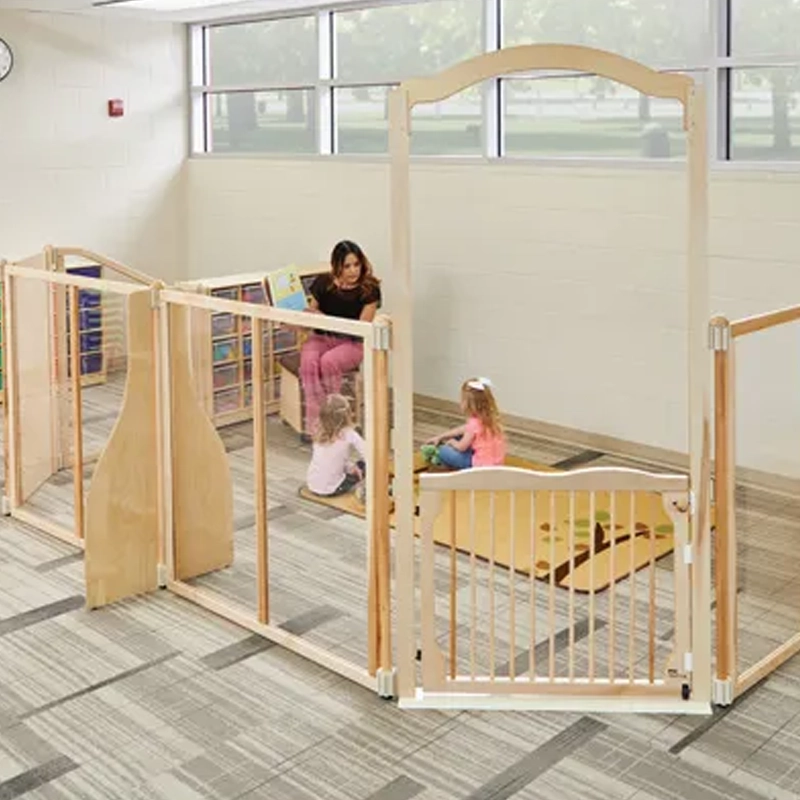
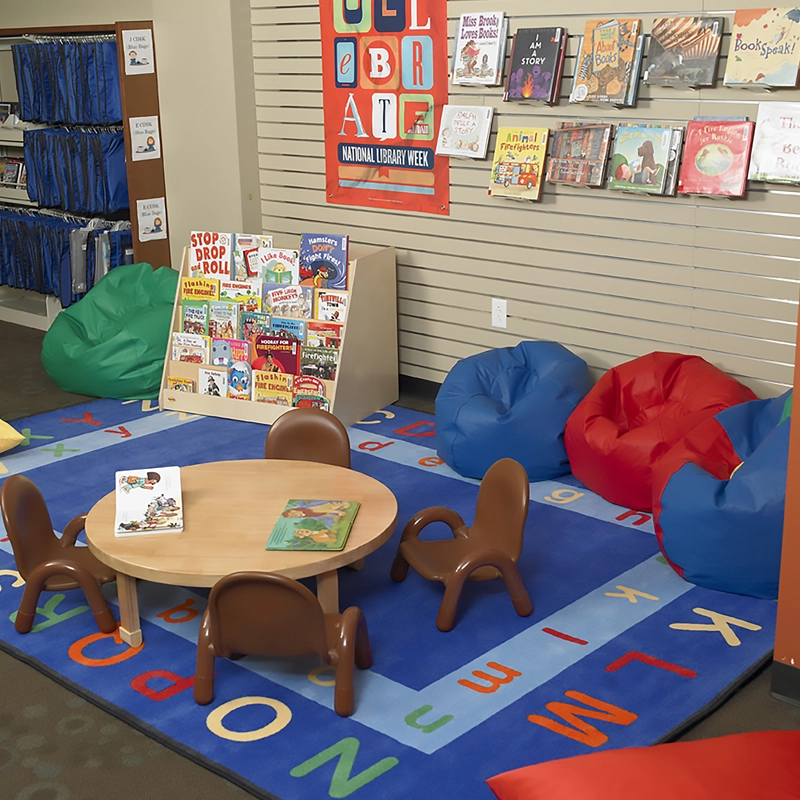
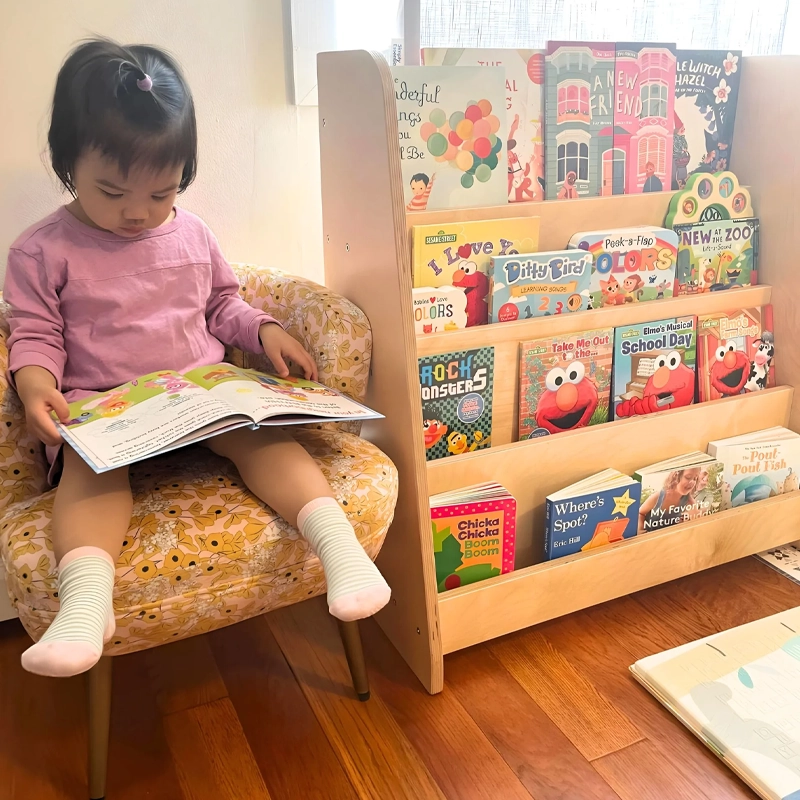
โซนเปิดที่ยืดหยุ่น
เด็กก่อนวัยเรียนจะได้รับประโยชน์จากกิจกรรมที่มีโครงสร้างชัดเจน แต่จะเติบโตได้ดีในสภาพแวดล้อมที่เอื้อต่อความเป็นธรรมชาติและการเปลี่ยนแปลง โซนเปิดที่มีความยืดหยุ่นเป็นพื้นที่อเนกประสงค์ที่ช่วยให้เกิดความคิดสร้างสรรค์ การทำงานร่วมกัน และการแสดงออกทางกายภาพ
โซนนี้อาจใช้เป็นกิจกรรมวงกลมในตอนเช้า เซสชันดนตรีหลังอาหารกลางวัน หรือเกมกลุ่มในช่วงเล่นฟรี นอกจากนี้ยังสามารถใช้เป็นพื้นที่เตรียมการสำหรับสัปดาห์ตามธีมหรือสถานีการเรียนรู้แบบหมุนเวียนได้อีกด้วย
เนื่องจากจุดประสงค์ที่เปลี่ยนไป โซนนี้จึงควรเปิดโล่งและไม่เกะกะ จัดเก็บวัสดุต่างๆ บนรถเข็นหรือชั้นวางที่เคลื่อนที่ไปตามผนัง และใช้ที่นั่งหรือเสื่อแบบวางซ้อนกันได้ซึ่งสามารถเคลื่อนย้ายได้ง่ายตามต้องการ
การออกแบบพื้นที่นี้ด้วยองค์ประกอบที่เบาและปรับเปลี่ยนได้ช่วยให้ครูตอบสนองต่อความต้องการในแต่ละวันของชั้นเรียนได้ นอกจากนี้ยังให้อิสระแก่เด็กๆ อีกด้วย โดยพวกเขาสามารถเต้นรำ สร้างสรรค์ จัดเรียง หรือสำรวจได้ ขึ้นอยู่กับช่วงเวลา
โซนเปิดแห่งนี้เหมาะเป็นอย่างยิ่งสำหรับสนามเด็กเล่นในร่มแบบแยกส่วน โดยที่ห้องหนึ่งจะต้องรองรับการเล่นหลายประเภทโดยไม่รู้สึกวุ่นวาย
รวม:
- พื้นที่โล่งไม่มีโครงสร้างตายตัว
- เก้าอี้ซ้อนได้หรือเบาะรองนั่งนุ่มๆ
- ถังเปิดหรือชั้นวางเคลื่อนที่สำหรับวัสดุหมุนเวียน
- พื้นที่สำหรับดนตรีกลุ่ม การเต้นรำ หรือการเคลื่อนไหว
- พื้นที่ผนังสำหรับฉายภาพหรือการตกแต่งตามธีม
- การกำหนดขอบเขตภาพโดยใช้เทปปูพื้นหรือพรม
ห้องเรียนที่สมบูรณ์แบบของคุณอยู่ห่างออกไปเพียงคลิกเดียว!
วิธีการเลือกอุปกรณ์สนามเด็กเล่นในร่มสำหรับเด็กก่อนวัยเรียนให้เหมาะสม
ความสำเร็จของสนามเด็กเล่นในร่มของโรงเรียนอนุบาลขึ้นอยู่กับอุปกรณ์ที่คุณเลือกเป็นหลัก อุปกรณ์ที่เหมาะสมจะช่วยเสริมความปลอดภัย ส่งเสริมพัฒนาการ และสอดคล้องกับกิจวัตรประจำวันและข้อจำกัดด้านพื้นที่ของโรงเรียนอนุบาลของคุณ ตั้งแต่โครงสร้างสนามเด็กเล่นแบบนิ่มไปจนถึงแผงสัมผัสแบบโต้ตอบ การเลือกอุปกรณ์จะต้องตรงกับความต้องการของเด็กๆ และสภาพแวดล้อมทางกายภาพของโรงเรียน
จับคู่อุปกรณ์ให้เหมาะกับวัยและความต้องการพัฒนาการ
เด็กวัย 2-6 ขวบมีจำนวนเพิ่มมากขึ้น และในแต่ละช่วงวัยจะต้องมีการเล่นเฉพาะประเภท เด็กวัยเตาะแตะต้องการกิจกรรมที่อ่อนโยนและมีความเสี่ยงต่ำเพื่อสร้างความมั่นใจ ในขณะที่เด็กก่อนวัยเรียนที่โตกว่าจะได้ประโยชน์จากโครงสร้างที่ท้าทายและมีการโต้ตอบมากกว่า การเลือกสิ่งของที่เหมาะสมสำหรับแต่ละกลุ่มอายุจะช่วยให้ปลอดภัยและมีส่วนร่วม
นี่คือข้อมูลอ้างอิงด่วนที่จะช่วยแนะนำการเลือกอุปกรณ์สนามเด็กเล่นในร่มสำหรับโรงเรียนอนุบาลของคุณ:
| กลุ่มอายุ | การมุ่งเน้นการพัฒนา | ประเภทอุปกรณ์ที่แนะนำ |
|---|---|---|
| 1–2 ปี (เด็กวัยเตาะแตะ) | การคลาน การยืน การปีนเบาๆ | บล็อกโฟมนุ่ม อุโมงค์คลาน ทางลาดบุด้วยโฟม ทางไต่เขาที่ต่ำ |
| 3–4 ปี | การทรงตัว การประสานงาน การเล่นสมมติ | สนามเด็กเล่นในร่มที่ปีนป่ายได้ แผงเล่นแบบโต้ตอบ |
| 5–6 ปี | ความแข็งแกร่ง ความคล่องตัว ธีมแห่งจินตนาการ | ชุดสนามเด็กเล่นขนาดเล็ก, เครื่องปีนป่ายแบบแยกส่วน, โซนเล่นแกล้งทำ |
การวางแผนที่เหมาะสมนี้มีความจำเป็นสำหรับพื้นที่สนามเด็กเล่นในร่มสำหรับเด็กวัยเตาะแตะ ซึ่งการเคลื่อนไหวในช่วงแรกๆ ต้องใช้การรองรับแรงกระแทกพิเศษและโครงสร้างที่มีระยะห่างต่ำ เมื่อเด็กๆ เติบโตขึ้น สภาพแวดล้อมในร่มควรพัฒนาไปพร้อมกับพวกเขา
ลองบูรณาการ:
- นักปีนผาโฟมต่ำพร้อมที่จับ
- อุโมงค์คลานทำจากไวนิลอ่อนหรือโฟม EVA
- โครงสนามเด็กเล่นในร่มแบบจังเกิ้ลยิมขนาดเล็ก
- หน่วยคอมโบสไลด์และไต่
- แกล้งทำเป็นเล่นมุมด้วยอุปกรณ์ประกอบฉากตามวัย
ให้ความสำคัญกับความปลอดภัยและความสะอาด
ความปลอดภัยเป็นสิ่งที่ไม่อาจต่อรองได้เมื่อต้องเลือกอุปกรณ์สำหรับสนามเด็กเล่นในร่มของโรงเรียนอนุบาล เด็กๆ จะได้สำรวจร่างกายของตนเอง เช่น ปีนป่าย กลิ้งตัว และทดสอบขอบเขต พื้นที่ในร่มของคุณควรปกป้องพวกเขาในขณะที่ยังให้การเคลื่อนไหวตามธรรมชาติ
เลือกอุปกรณ์ที่ทำจากวัสดุที่ไม่เป็นพิษ นุ่ม และทนทาน มองหาพื้นผิวที่นุ่มสบาย ขอบโค้งมน และยึดติดแน่น หลีกเลี่ยงโลหะที่เปิดเผย ขอบคม หรือกลไกที่ซับซ้อนซึ่งอาจทำให้เด็กเล็กหนีบนิ้วได้ วัสดุสนามเด็กเล่นในร่มที่นุ่ม เช่น โฟมเคลือบไวนิลหรือพลาสติกปิดผนึก ช่วยปกป้องและทำความสะอาดได้ง่าย
การทำความสะอาดเป็นกิจกรรมประจำวันในศูนย์การเรียนรู้ช่วงต้น การออกแบบอุปกรณ์สนามเด็กเล่นในร่มที่ดีที่สุดสำหรับโรงเรียนอนุบาลต้องคำนึงถึงความง่ายในการเช็ดหรือฆ่าเชื้อพื้นผิว โครงสร้างไร้รอยต่อ พื้นผิวทนต่อคราบ และฐานกันลื่นทำให้การบำรุงรักษาง่ายขึ้นโดยไม่ต้องเสียสละความปลอดภัย
สิ่งที่ต้องมองหา:
- วัสดุสนามเด็กเล่นในร่มที่ผ่านการรับรองปลอดสารพิษ
- มุมโค้งมนและการเชื่อมต่อแบบปิดผนึก
- พื้นกันลื่นพร้อมรองรับแรงกระแทก
- เคลือบสัมผัสอ่อนนุ่มเพื่อป้องกันแรงกระแทก
- พื้นผิวที่ทำความสะอาดง่ายสำหรับพื้นผิวสัมผัสสูง
สมดุลความหลากหลายกับความเรียบง่าย
สนามเด็กเล่นในร่มที่มีประสิทธิภาพสำหรับเด็กก่อนวัยเรียนไม่จำเป็นต้องมีคุณสมบัติครบครันทุกอย่าง ความหลากหลายมากเกินไปอาจทำให้เด็กๆ สับสนหรือกระตุ้นมากเกินไป ควรเน้นที่ชิ้นส่วนที่สามารถใช้งานได้หลากหลายและปรับเปลี่ยนรูปแบบได้แทน
โครงสร้างอเนกประสงค์ เช่น ชุดสนามเด็กเล่นในร่มแบบแยกส่วน ถือเป็นโครงสร้างที่เหมาะสมที่สุด โดยสามารถให้เด็กๆ ไถล ปีนป่าย ทรงตัว และคลานได้ในหนึ่งเดียว ชิ้นส่วนที่เปลี่ยนกันได้ยังช่วยให้คุณปรับเปลี่ยนเลย์เอาต์ได้ตามกาลเวลา ทำให้สภาพแวดล้อมดูสดชื่นและน่าตื่นเต้น
ความซับซ้อนมากเกินไปอาจนำไปสู่การเล่นที่วุ่นวาย การจัดวางที่เรียบง่ายและมีเป้าหมายชัดเจนจะสร้างประสบการณ์ที่มีความหมายมากขึ้นและการจัดการห้องเรียนที่ง่ายขึ้น
พิจารณาใช้:
- ลูกบาศก์ปีนเขาและทางลาดอเนกประสงค์
- การรวมกันของอุโมงค์และสไลด์ที่สามารถวางซ้อนกันได้
- แผงสัมผัสแบบหมุนที่มีพื้นผิวหลากหลาย
- การจัดกลุ่มเล็ก ๆ เพื่อส่งเสริมการมีปฏิสัมพันธ์ร่วมกัน
เมื่อใดจึงควรพิจารณาอุปกรณ์ที่กำหนดเอง
โรงเรียนส่วนใหญ่เริ่มต้นด้วยชุดมาตรฐานที่คุ้มต้นทุน ปรับขนาดได้ และติดตั้งได้อย่างรวดเร็ว อย่างไรก็ตาม อุปกรณ์สนามเด็กเล่นในร่มที่ปรับแต่งได้อาจให้คุณค่าในระยะยาวที่ดีกว่าเมื่อโรงเรียนอนุบาลของคุณเติบโตขึ้น
ตัวเลือกที่กำหนดเองช่วยให้คุณจัดวางอุปกรณ์ให้เข้ากับผังพื้นที่เฉพาะ สอดคล้องกับเป้าหมายการศึกษา (เช่น มอนเตสซอรี) หรือสะท้อนถึงเอกลักษณ์ของโรงเรียนอนุบาลของคุณ พื้นที่เก็บของแบบบูรณาการ หน่วยตามธีม หรือสีของแบรนด์สามารถเสริมความรู้สึกโดยรวมของพื้นที่ในร่มของคุณได้
ร่วมงานกับผู้ผลิตสนามเด็กเล่นในร่มมืออาชีพที่เข้าใจวิสัยทัศน์ของคุณและเสนอบริการสนับสนุนการวางแผน ซัพพลายเออร์หลายรายจัดหาระบบโมดูลาร์แบบกึ่งกำหนดเองที่ผสมผสานการคำนึงถึงงบประมาณกับผลลัพธ์ที่ปรับแต่งได้
แนะนำเมื่อ:
- เค้าโครงของคุณมีความท้าทายด้านพื้นที่ที่ไม่ซ้ำใคร
- คุณต้องการที่จะสะท้อนถึงธีมหรือแนวทางการสอน (เช่น มอนเตสซอรี)
- คุณต้องการฟังก์ชันการใช้งานแบบผสมผสาน (พื้นที่เก็บข้อมูล + การเล่น)
- คุณต้องการรวมเอาสุนทรียศาสตร์ของแบรนด์โรงเรียนของคุณเข้าไว้ด้วยกัน
- คุณกำลังมองหาความยืดหยุ่นในระยะยาวผ่านการปรับแต่งแบบโมดูลาร์

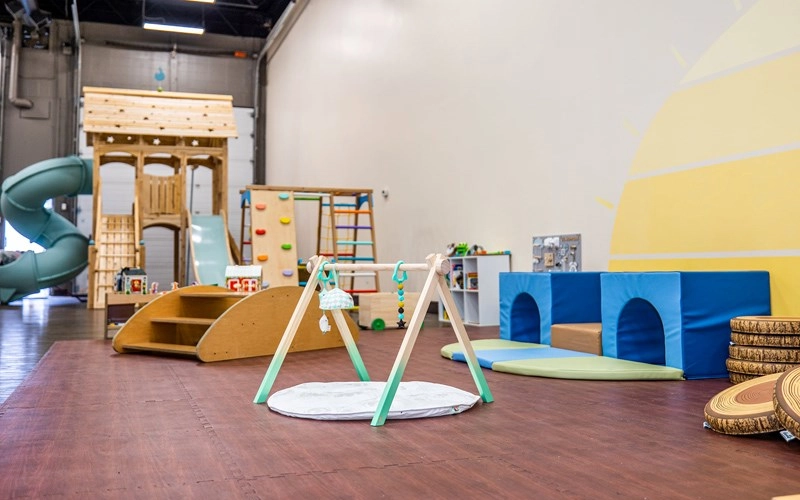
การออกแบบสนามเด็กเล่นแบบกำหนดเองหรือแบบมาตรฐาน: แบบไหนดีกว่าสำหรับโรงเรียนอนุบาล?
เมื่อวางแผนสร้างสนามเด็กเล่นในร่มสำหรับเด็กก่อนวัยเรียน การตัดสินใจออกแบบที่สำคัญที่สุดอย่างหนึ่งที่คุณต้องเผชิญคือการใช้อุปกรณ์โมดูลาร์มาตรฐานหรือลงทุนออกแบบเอง แนวทางทั้งสองมีจุดแข็งที่แตกต่างกัน การเลือกที่ถูกต้องขึ้นอยู่กับพื้นที่ เป้าหมาย และวิสัยทัศน์ระยะยาวสำหรับโรงเรียนของคุณ
ชุดโมดูลาร์มาตรฐาน: เรียบง่าย ปรับขนาดได้ เชื่อถือได้
ระบบสนามเด็กเล่นในร่มแบบโมดูลาร์เป็นชุดอุปกรณ์ที่ออกแบบไว้ล่วงหน้าพร้อมคุณสมบัติพื้นฐานสำหรับการปีนป่าย การเลื่อน และการคลาน โดยสร้างขึ้นเพื่อให้เหมาะกับพื้นที่ต่างๆ และสามารถติดตั้งได้อย่างรวดเร็วโดยแทบไม่ต้องวางแผนใดๆ
ชุดมาตรฐานเป็นโซลูชันที่ปลอดภัยและราคาไม่แพงสำหรับโรงเรียนที่เพิ่งเริ่มต้นหรือมีงบประมาณจำกัด ชุดมาตรฐานเหล่านี้เป็นไปตามข้อบังคับด้านความปลอดภัย รองรับการพัฒนาทางกายภาพทั่วไป และใช้งานได้ดีในห้องอเนกประสงค์
ระบบโมดูลาร์มักสามารถขยายได้ คุณสามารถเริ่มต้นด้วยโครงสร้างหลักแล้วค่อยเพิ่มคุณสมบัติ เช่น บ่อบอล ผนังกิจกรรม หรือเครื่องเล่นปีนป่ายเพิ่มเติมในภายหลังเมื่องบประมาณหรือพื้นที่ของคุณเพิ่มขึ้น
ดีที่สุดสำหรับ:
- โรงเรียนอนุบาลแห่งใหม่หรือขนาดเล็กที่มีเงินทุนจำกัด
- โรงเรียนที่เช่าพื้นที่และต้องการโซลูชั่นแบบเคลื่อนที่หรือกึ่งถาวร
- การติดตั้งอย่างรวดเร็วด้วยความต้องการปรับแต่งที่น้อยที่สุด
- สภาพแวดล้อมที่ต้องการโครงสร้างที่เรียบง่ายและการบำรุงรักษาต่ำ
การออกแบบสนามเด็กเล่นในร่มแบบกำหนดเอง: สร้างขึ้นเพื่อจุดประสงค์เฉพาะและสอดคล้องกับแบรนด์
การออกแบบที่กำหนดเองช่วยให้คุณสามารถสร้างสนามเด็กเล่นในร่มสำหรับโรงเรียนอนุบาลที่สะท้อนถึงปรัชญาการศึกษา เอกลักษณ์ของแบรนด์ และรูปแบบทางกายภาพของโรงเรียนของคุณ ไม่ว่าคุณต้องการสนับสนุนวิธีการแบบมอนเตสซอรี สร้างสภาพแวดล้อมตามธีม หรือใช้พื้นที่ที่ไม่แน่นอน การปรับแต่งจะช่วยให้คุณก้าวไปไกลกว่าโซลูชันมาตรฐาน
สนามเด็กเล่นในร่มสำหรับเด็กก่อนวัยเรียนที่ออกแบบเองอาจรวมเอาโซนสัมผัส คุณลักษณะการเล่นตามจินตนาการ มุมอ่านหนังสือ และความท้าทายด้านการเคลื่อนไหวร่างกายเข้าไว้ด้วยกันเป็นโครงสร้างที่สอดประสานกัน ซึ่งทั้งหมดได้รับการปรับแต่งให้เหมาะกับพื้นที่และหลักสูตรของคุณ คุณสามารถผสานรวมพื้นที่จัดเก็บในตัว แสงไฟนวลๆ สีของแบรนด์ หรือองค์ประกอบที่ได้รับแรงบันดาลใจจากธรรมชาติหรือวัฒนธรรม
โซลูชันแบบกำหนดเองมักต้องมีการวางแผน เวลา และงบประมาณมากขึ้น แต่ให้มูลค่าในระยะยาวที่สูงกว่า โดยเฉพาะในตลาดโรงเรียนที่มีการแข่งขันสูง ซึ่งความประทับใจของผู้ปกครองเป็นสิ่งสำคัญ
มักใช้เมื่อ:
- คุณมีรูปแบบที่เป็นเอกลักษณ์หรือรูปแบบที่จำกัด
- คุณต้องการผสมผสานพื้นที่เล่นเข้ากับโซนห้องเรียน
- คุณกำลังสร้างแบรนด์พื้นที่ของคุณให้เป็นส่วนหนึ่งของเอกลักษณ์โรงเรียนของคุณ
- คุณมุ่งเน้นไปที่การลงทุนระยะยาวและความสามารถในการปรับตัว
- คุณต้องการอุปกรณ์ที่รองรับเป้าหมายการเรียนรู้ที่เฉพาะเจาะจง
ความแตกต่างที่สำคัญโดยย่อ
| คุณสมบัติ | ชุดโมดูลาร์มาตรฐาน | สนามเด็กเล่นในร่มที่ออกแบบตามสั่ง |
|---|---|---|
| ระยะเวลาในการติดตั้ง | รวดเร็ว (ออกแบบไว้ล่วงหน้า มีจำหน่าย) | นานกว่า (ต้องมีการวางแผน การออกแบบ และการประสานงาน) |
| ค่าใช้จ่าย | ต้นทุนเบื้องต้นลดลง | ความยืดหยุ่นล่วงหน้าที่สูงขึ้น ระยะยาวที่ดีขึ้น |
| พอดีกับพื้นที่ | พอดีทั่วไป | ออกแบบให้เข้ากับเค้าโครง เพิ่มประสิทธิภาพทุกซอกมุม |
| การบูรณาการทางการศึกษา | องค์ประกอบการเล่นพื้นฐาน | สามารถรวมคุณลักษณะที่เชื่อมโยงกับหลักสูตรหรือเฉพาะหัวข้อได้ |
| การสร้างแบรนด์และภาพ | ลักษณะทั่วไป | ปรับแต่งได้เต็มที่ (สี วัสดุ โครงสร้าง) |
| มูลค่าระยะยาว | ปรับขนาดได้แต่ปรับแต่งได้จำกัด | ความยืดหยุ่นสูง การมีส่วนร่วมที่ลึกซึ้งยิ่งขึ้น |
จะตัดสินใจอย่างไร?
แนวทางแบบผสมผสานนั้นเหมาะที่สุดสำหรับโรงเรียนอนุบาลหลายๆ แห่ง โดยผสมผสานฐานแบบแยกส่วนเข้ากับส่วนเพิ่มเติมที่กำหนดเองเพียงไม่กี่ส่วน วิธีนี้จะทำให้คุณมีความยืดหยุ่นและมีพื้นที่ในการเติบโตตามความต้องการที่เปลี่ยนแปลงไป ตัวอย่างเช่น เริ่มต้นด้วยโครงสร้างหลักสำหรับการปีนป่ายและคลาน จากนั้นจึงเพิ่มมุมเล่นตามจินตนาการหรือมุมอ่านหนังสือที่ออกแบบเองในภายหลัง
ไม่ว่าคุณจะกำลังสร้างสนามเด็กเล่นในร่มสำหรับเด็กก่อนวัยเรียนใหม่หรือปรับปรุงสนามเด็กเล่นที่มีอยู่ การเลือกเค้าโครงและอุปกรณ์ต่างๆ ของคุณจะเป็นตัวกำหนดว่าเด็กๆ จะเรียนรู้และเล่นในแต่ละวันอย่างไร ดังนั้นการร่วมมือกับซัพพลายเออร์ที่เข้าใจการศึกษาปฐมวัยจึงมีความสำคัญ ไม่ใช่แค่ความปลอดภัยของสนามเด็กเล่นเท่านั้น
ที่ Xiair World เรามีความเชี่ยวชาญด้านโซลูชันสนามเด็กเล่นในร่มสำหรับก่อนวัยเรียนที่ออกแบบมาเพื่อสภาพแวดล้อมการเรียนรู้ในช่วงเริ่มต้น ในฐานะผู้ให้บริการแบบครบวงจร เฟอร์นิเจอร์โรงเรียนอนุบาล และซัพพลายเออร์อุปกรณ์ เราให้บริการทุกอย่างตั้งแต่การวางแผนพื้นที่และการเลือกอุปกรณ์ไปจนถึงการออกแบบและการผลิตแบบกำหนดเอง ไม่ว่าคุณจะต้องการชุดสนามเด็กเล่นในร่มแบบนุ่ม โครงสร้างเสริมกล้ามเนื้อมัดใหญ่แบบแยกส่วน หรือมุมเรียนรู้ตามธีม เรายินดีช่วยคุณสร้างพื้นที่เล่นที่ปลอดภัย สร้างแรงบันดาลใจ และสร้างให้คงทน
หากคุณกำลังวางแผนสร้างสนามเด็กเล่นในร่มระดับก่อนวัยเรียนครั้งต่อไป ให้เราช่วยคุณทำให้วิสัยทัศน์ของคุณกลายเป็นจริง โดยมีแนวคิดที่เป็นประโยชน์ วัสดุที่เป็นไปตามมาตรฐาน และการออกแบบที่เน้นเด็กเป็นศูนย์กลางซึ่งใช้งานได้จริง
อย่าแค่ฝัน แต่จงออกแบบมัน! มาพูดคุยเกี่ยวกับความต้องการเฟอร์นิเจอร์สั่งทำของคุณกันเถอะ!
การพิจารณาเรื่องความปลอดภัย สุขอนามัย และวัสดุ
ความปลอดภัยและความสะอาดไม่ใช่ทางเลือกในสนามเด็กเล่นในร่มของโรงเรียนอนุบาล — สิ่งเหล่านี้มีความจำเป็น เด็ก ๆ ในวัยนี้จะสำรวจโลกผ่านการเคลื่อนไหวและการสัมผัส ดังนั้นอุปกรณ์ทุกชิ้น พื้นผิวทุกชิ้น และวัสดุทุกชิ้นจะต้องรองรับการเล่นที่ปลอดภัย มีสุขภาพดี และไร้กังวล
เริ่มต้นด้วยอุปกรณ์ที่นุ่มและดูดซับแรงกระแทก
เด็กก่อนวัยเรียนล้ม ปีนป่าย คลาน และมักจะล้มลง นั่นคือเหตุผลที่วัสดุที่อ่อนนุ่มจึงเป็นพื้นฐานของสนามเด็กเล่นในร่มที่ปลอดภัย เครื่องเล่นปีนป่ายที่ทำจากโฟม แผ่นรองที่หุ้มไวนิล และโครงสร้างพลาสติกทรงกลมช่วยลดความเสี่ยงต่อการบาดเจ็บ พร้อมทั้งช่วยส่งเสริมพัฒนาการด้านกล้ามเนื้อและความมั่นใจ
พื้นผิวควรนุ่มแต่แข็งแรงเพียงพอที่จะรองรับน้ำหนักได้ และควรยึดโครงสร้างให้แน่นหนาเพื่อหลีกเลี่ยงการพลิกคว่ำ หลีกเลี่ยงโครงไม้หรือโลหะ เว้นแต่จะมีแผ่นรองและออกแบบมาสำหรับเด็กปฐมวัย
การเลือกใช้วัสดุที่สำคัญเพื่อความปลอดภัย:
- โฟม EVA หรือโฟม PU ความหนาแน่นสูง
- ภายนอกเคลือบไวนิลสำหรับพื้นผิวที่เช็ดทำความสะอาดได้
- มุมโค้งมน ตะเข็บเรียบ และไม่มีฮาร์ดแวร์ที่เปิดเผย
- พื้นกันลื่นพร้อมแผ่นรองรับแรงกระแทก
ออกแบบมาเพื่อการทำความสะอาดทุกวันและสุขอนามัยระยะยาว
เด็กๆ มักจะหก จาม และเล่นด้วยมือ ดังนั้นวัสดุที่ทำความสะอาดง่ายจึงมีความสำคัญในสนามเด็กเล่นในร่มของโรงเรียนอนุบาล เลือกพื้นผิวที่สามารถเช็ดได้หลายครั้งต่อวันโดยไม่แตกร้าว เปื้อน หรือดูดซับความชื้น
อุปกรณ์ควรทนทานต่อเชื้อรา แบคทีเรีย และกลิ่นไม่พึงประสงค์ ส่วนประกอบแบบแยกส่วนที่สามารถถอดและฆ่าเชื้อได้ทีละชิ้นทำให้ทำความสะอาดอย่างล้ำลึกได้ง่ายขึ้น
หลีกเลี่ยงวัสดุที่มีรูพรุน ผ้าหลวมๆ หรือสิ่งของใดๆ ที่ยากต่อการฆ่าเชื้อ โดยเฉพาะในบริเวณที่มีการสัมผัสบ่อย เช่น ราวจับสำหรับปีนป่ายหรือทางเข้าอุโมงค์
มองหาคุณสมบัติที่เน้นด้านสุขอนามัย เช่น:
- พื้นผิวปิดผนึกปลอดสารพิษ
- สารเคลือบป้องกันน้ำและป้องกันจุลินทรีย์
- โครงสร้างแผงแบบไร้รอยต่อ
- ปลอกหรือชั้นที่ถอดออกได้และซักได้
- การปฏิบัติตามมาตรฐานสุขอนามัยระดับสถานรับเลี้ยงเด็ก
การปฏิบัติตามและการบำรุงรักษาอย่างต่อเนื่อง
ไม่ว่าจะติดตั้งสนามเด็กเล่นในร่มขนาดเล็กสำหรับเด็กก่อนวัยเรียนหรือจัดวางพื้นที่ให้เท่ากับห้องเรียน อุปกรณ์ทั้งหมดควรเป็นไปตามกฎความปลอดภัยของเด็กในท้องถิ่นและระเบียบข้อบังคับของสนามเด็กเล่นในร่ม ซึ่งรวมถึงระยะห่างระหว่างอุปกรณ์ ข้อจำกัดด้านความสูง และการทดสอบวัสดุ
การบำรุงรักษาตามปกติมีความสำคัญพอๆ กับการติดตั้งครั้งแรก สร้างรายการตรวจสอบสำหรับการตรวจสอบประจำวัน การทำความสะอาดประจำสัปดาห์ และการตรวจสอบความปลอดภัยประจำเดือน วัสดุที่ชำรุดหรือเสื่อมสภาพควรเปลี่ยนใหม่ทันทีเพื่อรักษาสภาพแวดล้อมของคุณให้ปลอดภัย
การเป็นพันธมิตรกับซัพพลายเออร์มืออาชีพช่วยให้แน่ใจว่าสนามเด็กเล่นในร่มก่อนวัยเรียนของคุณเป็นไปตามมาตรฐานความปลอดภัยทุกประการ ไม่ใช่แค่เพียงตอนติดตั้งเท่านั้น แต่ตลอดหลายปีที่ใช้งาน
การสนับสนุนจากผู้เชี่ยวชาญเพื่อพื้นที่เล่นที่ปลอดภัยและมีสุขภาพดี
ในฐานะซัพพลายเออร์ที่มุ่งเน้นเฉพาะสภาพแวดล้อมสำหรับเด็กปฐมวัย เราเข้าใจดีว่าความปลอดภัยเป็นมากกว่ารายการตรวจสอบ แต่เป็นส่วนหนึ่งของความรับผิดชอบประจำวันของโรงเรียนของคุณ ที่ Xiair World เรามอบโซลูชันสนามเด็กเล่นในร่มสำหรับโรงเรียนอนุบาลเพื่อความสบายใจและการเรียนรู้ที่สนุกสนาน
ตั้งแต่การแนะนำอุปกรณ์สนามเด็กเล่นในร่มปลอดสารพิษไปจนถึงการช่วยคุณออกแบบเค้าโครงที่ลดความเสี่ยงการบาดเจ็บและเพิ่มการทำความสะอาดให้สูงสุด เราให้การสนับสนุนคุณในทุกขั้นตอนตั้งแต่การวางแผนจนถึงการดูแลหลังการติดตั้ง

ไอเดียการออกแบบสร้างสรรค์และการศึกษา
สนามเด็กเล่นในร่มที่ดีไม่เพียงแต่เป็นสถานที่สำหรับเผาผลาญพลังงานเท่านั้น แต่ยังเป็นสภาพแวดล้อมในการเรียนรู้ด้วย การออกแบบและตกแต่งพื้นที่สามารถกำหนดได้ว่าเด็กๆ จะคิด รู้สึก และโต้ตอบกันอย่างไร ด้วยการวางแผนอย่างรอบคอบ สนามเด็กเล่นในร่มของคุณจะกลายเป็นส่วนขยายตามธรรมชาติของเป้าหมายทางการศึกษาของคุณ ซึ่งรองรับทุกอย่างตั้งแต่การพัฒนาภาษาไปจนถึงการแสดงออกทางอารมณ์
ผสมผสานการเรียนรู้กับการเล่น
เมื่อเด็กเล่น พวกเขาไม่ได้แค่เคลื่อนไหวเท่านั้น แต่พวกเขากำลังแก้ปัญหา สำรวจภาษา และทดสอบขอบเขตอีกด้วย การนำองค์ประกอบด้านการศึกษามาผสมผสานเข้ากับสนามเด็กเล่นในร่มก่อนวัยเรียนโดยตรงจะช่วยให้เด็กๆ เพื่อเรียนรู้ในขณะที่พวกเขาปีน สร้าง หรือแกล้งทำ
ตัวอย่างเช่น โครงสร้างสำหรับการปีนป่ายอาจรวมถึงตัวเลขหรือตัวอักษรบนขั้นบันได กำแพงสัมผัสอาจมีคำศัพท์หรือรูปแบบสี และพื้นที่เล่นตามจินตนาการอาจปฏิบัติตามธีมประจำสัปดาห์ของห้องเรียน เช่น ฤดูกาล สัตว์ หรือผู้ช่วยเหลือในชุมชน
แนวคิดทางการศึกษาที่น่าสำรวจ:
- สติ๊กเกอร์ตัวอักษรและตัวเลขบนแผงสำหรับปีนป่าย
- การกระตุ้นเรื่องราวหรือลำดับภาพใกล้อุโมงค์หรือมุมเล่นบทบาทสมมติ
- องค์ประกอบ STEM ง่ายๆ เช่น ผนังแม่เหล็กหรือเฟือง
- เกมจับคู่สีที่สร้างไว้ในเสื่อปูพื้นหรือบล็อกนุ่มๆ
ใช้สีและพื้นผิวเพื่อส่งผลต่ออารมณ์
สีเป็นเครื่องมือที่มีประสิทธิภาพในการออกแบบสนามเด็กเล่นในร่มที่สร้างสรรค์ สีสันสดใส เช่น สีแดงและสีส้ม ช่วยกระตุ้นกิจกรรม ในขณะที่สีน้ำเงินและสีเขียวช่วยส่งเสริมความสงบ การใช้โซนสีต่างๆ ช่วยให้เด็กๆ ระบุประเภทของกิจกรรมที่คาดหวังไว้ในพื้นที่นั้นๆ ได้ เช่น การเล่นที่กระตือรือร้นเทียบกับช่วงเวลาเงียบๆ
พื้นผิวก็มีบทบาทสำคัญเช่นกัน ผ้าเนื้อนุ่มในบริเวณที่เงียบ เสื่อที่มีพื้นผิวขรุขระในบริเวณที่สัมผัสได้ และไวนิลที่เรียบในบริเวณที่มีคนเดินผ่านไปมามาก ช่วยให้เด็กๆ สัมผัสได้ถึงความเชื่อมโยงระหว่างพื้นที่ นอกจากนี้ การมองเห็นยังช่วยพัฒนาความจำและสมาธิอีกด้วย
การออกแบบโดยคำนึงถึงประสาทสัมผัสต่างๆ จะช่วยให้ประสบการณ์สนามเด็กเล่นในร่มมีความสมบูรณ์และน่าดึงดูดใจมากขึ้น
ร่วมเฉลิมฉลองความหลากหลายทางวัฒนธรรมและภาษา
ของคุณ สนามเด็กเล่นในร่มก่อนวัยเรียน สามารถสะท้อนถึงคุณค่าของชุมชนของคุณได้ เพิ่มหนังสือ โปสเตอร์ หรือสติกเกอร์ติดผนังในหลายภาษา จัดแสดงเครื่องดนตรี ตุ๊กตา หรืออาหารเล่นจากวัฒนธรรมต่างๆ ใช้ป้ายที่มีรูปภาพที่ครอบคลุมและเชิญชวนให้เด็กๆ สำรวจประเพณีและวิถีชีวิตอื่นๆ
การออกแบบแบบพหุวัฒนธรรมไม่จำเป็นต้องซับซ้อน รายละเอียดเล็กๆ น้อยๆ สื่อถึงข้อความสำคัญเกี่ยวกับการต้อนรับ การรวมกลุ่ม และการเป็นตัวแทน
องค์ประกอบเหล่านี้ยังสนับสนุนการเรียนรู้ทางสังคมและอารมณ์ และช่วยให้เด็กๆ ได้ถามคำถาม แสดงออกถึงตัวตน และสร้างความเห็นอกเห็นใจ
นำธีมหลักสูตรมาสู่สนามเด็กเล่น
วิธีหนึ่งในการเชื่อมโยงการเรียนรู้กับการเล่นโดยตรงคือการขยายธีมของห้องเรียนของคุณไปสู่สนามเด็กเล่นในร่ม หากหลักสูตรของคุณมีเนื้อหาเกี่ยวกับอวกาศ ให้เปลี่ยนอุโมงค์เป็นยานอวกาศ เรียนรู้เกี่ยวกับสัตว์ต่างๆ หรือไม่ เพิ่มรอยเท้าลงบนพื้นหรือตกแต่งนักไต่เขาให้ดูเหมือนป่า
แนวทางนี้ทำให้สนามเด็กเล่นในร่มของโรงเรียนอนุบาลของคุณดูเป็นหนึ่งเดียวกัน ไม่แยกจากกัน เป็นพื้นที่ที่บทเรียนต่างๆ กลายเป็นจริง นอกจากนี้ยังกระตุ้นให้เด็กๆ มีส่วนร่วมมากขึ้น และช่วยเสริมสร้างสิ่งที่พวกเขาเรียนรู้จากที่อื่น
การรวมและการเข้าถึงในสนามเด็กเล่นก่อนวัยเรียน
สนามเด็กเล่นในร่มที่ออกแบบมาอย่างดีไม่เพียงแต่เป็นพื้นที่สนุกสนานเท่านั้น แต่ยังเป็นการแสดงออกถึงคุณค่าของโรงเรียนอีกด้วย การรวมกลุ่มและการเข้าถึงได้ไม่ใช่อุดมคติที่เลือกได้อีกต่อไป แต่เป็นสิ่งจำเป็นสำหรับสภาพแวดล้อมใดๆ ที่ให้บริการเด็กๆ
เด็กทุกคนสมควรได้รับการต้อนรับ ปลอดภัย และมีพลังที่จะเล่น ไม่ว่าพวกเขาจะมีความสามารถหรือภูมิหลังเป็นอย่างไร ซึ่งรวมถึงเด็กที่มีความพิการทางร่างกาย ความไวต่อประสาทสัมผัส ความล่าช้าในการพัฒนา หรือมีความต้องการทางสังคมและอารมณ์
ออกแบบสำหรับทุกความสามารถ
การมีส่วนร่วมเริ่มต้นด้วยการออกแบบที่ใส่ใจ สนามเด็กเล่นในร่มที่มีส่วนร่วมช่วยให้เด็กๆ ทุกคนเข้าถึงและสนุกสนานกับพื้นที่ได้โดยไม่รู้สึกถูกละเลย
ซึ่งรวมถึงทางเดินกว้างสำหรับรถเข็นหรืออุปกรณ์ช่วยเดิน อุปกรณ์ระดับต่ำที่ไม่ต้องปีนป่าย และเครื่องเล่นที่กระตุ้นพัฒนาการโดยไม่มากเกินไป องค์ประกอบทางสายตาและการได้ยินควรเป็นแบบนุ่มนวล คาดเดาได้ และไม่ฉูดฉาดจนเกินไป
สำหรับเด็กที่ไม่สามารถพูดได้หรือเด็กที่ประมวลผลข้อมูลแตกต่างกัน การจัดวางควรรองรับสัญลักษณ์ภาพที่ชัดเจน โซนที่นำทางง่าย และพื้นที่ปลอดภัยสำหรับการเล่นคนเดียว
องค์ประกอบที่ต้องพิจารณาสำหรับการเข้าถึง:
- ทางลาดแทนขั้นบันได
- ราวจับบนชานชาลา
- แผงเล่นแบบสัมผัสและมีพื้นผิว
- การแบ่งโซนภาพด้วยสีหรือแสง
- มุมสงบหรือพื้นที่พักผ่อนเพื่อการควบคุมประสาทสัมผัส
การสนับสนุนความต้องการทางประสาทสัมผัสและอารมณ์
เด็กๆ จำนวนมาก — ไม่ใช่แค่เด็กที่ได้รับการวินิจฉัยว่าเป็นโรค — ได้รับประโยชน์จากสนามเด็กเล่นในร่มที่ส่งเสริมประสาทสัมผัส ซึ่งหมายถึงการสร้างพื้นที่ที่สงบ ผ่อนคลาย และออกแบบมาเพื่อควบคุมอารมณ์
แสงไฟที่นุ่มนวล เสียงรบกวนที่ลดลง และการออกแบบภาพที่เรียบง่ายช่วยให้เด็กๆ รู้สึกควบคุมตัวเองได้ดีขึ้น องค์ประกอบต่างๆ เช่น ผนังฟิดเจ็ต เก้าอี้บีนแบ็ก และดนตรีเบาๆ ช่วยสนับสนุนการประมวลผลทางอารมณ์และลดความวิตกกังวล
นี่ไม่เพียงเป็นประโยชน์สำหรับเด็กแต่ละคนเท่านั้น แต่ยังช่วยปรับปรุงบรรยากาศการเรียนรู้ให้กับทุกคนอีกด้วย
ส่งเสริมการรวมกลุ่มทางสังคมผ่านการเล่นร่วมกัน
ในสนามเด็กเล่นในร่มระดับก่อนวัยเรียนแบบครอบคลุม เด็กๆ ทุกระดับความสามารถควรสามารถเล่นด้วยกันได้ ไม่ใช่แยกกันเล่น นั่นหมายความว่าต้องออกแบบประสบการณ์ร่วมกัน เช่น กำแพงดนตรีที่ตอบสนองต่อการสัมผัส เกมแบบโต้ตอบเหล่านี้ไม่จำเป็นต้องมีมุมพูดหรือมุมเล่นสมมติที่เด็กๆ สามารถเล่นบทบาทต่างๆ ได้โดยไม่คำนึงถึงความสามารถทางกายภาพ
เป้าหมายคือการส่งเสริมความเห็นอกเห็นใจ ความร่วมมือ และความสัมพันธ์กับเพื่อน ซึ่งเป็นทักษะที่จำเป็นในการพัฒนาเด็กปฐมวัย
การเล่นร่วมกันช่วยสร้างวัฒนธรรมแห่งการผูกพัน ทำให้สนามเด็กเล่นของคุณกลายเป็นพื้นที่ที่ยอมรับและเฉลิมฉลองความหลากหลาย

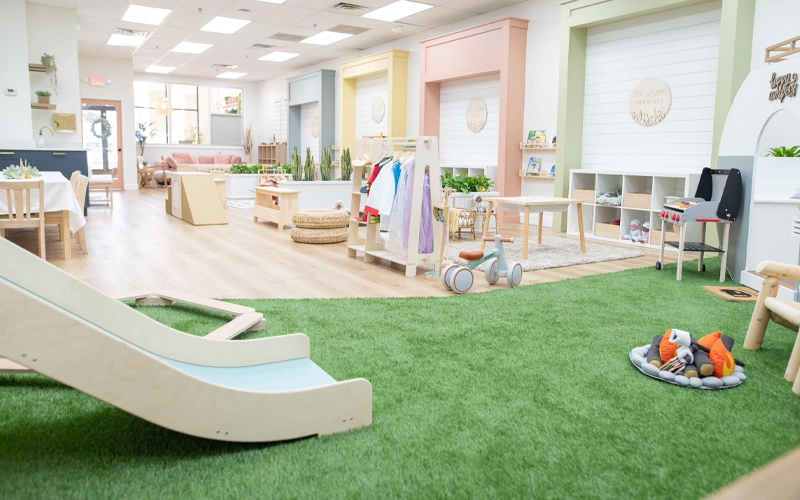
การวางแผนงบประมาณสำหรับสนามเด็กเล่นในร่มก่อนวัยเรียน
การสร้างสนามเด็กเล่นในร่มสำหรับโรงเรียนอนุบาลไม่ได้เป็นเพียงการเลือกอุปกรณ์ที่เหมาะสมเท่านั้น แต่ยังเป็นการลงทุนอย่างชาญฉลาดเพื่อสนับสนุนพัฒนาการของเด็กและการดำเนินงานของโรงเรียนในระยะยาว ไม่ว่าจะทำงานด้วยงบประมาณจำกัดหรือวางแผนการติดตั้งขนาดใหญ่ สิ่งสำคัญคือการสร้างสมดุลระหว่างต้นทุน ความปลอดภัย การใช้งาน และความยืดหยุ่นในอนาคต
ทำความเข้าใจหมวดหมู่ต้นทุนหลัก
เมื่อจัดงบประมาณสำหรับสนามเด็กเล่นในร่ม อย่าคิดแค่ราคาอุปกรณ์เพียงอย่างเดียว แผนที่สมบูรณ์ควรมีค่าใช้จ่ายต่างๆ เช่น:
- ให้คำปรึกษาด้านการออกแบบและจัดวางผัง
- ราคาอุปกรณ์สนามเด็กเล่นก่อนวัยเรียน
- การจัดส่งและการติดตั้ง
- พื้นและผนังบุด้วยวัสดุกันความร้อน
- การสร้างแบรนด์ที่กำหนดเองหรือการเพิ่มธีม
- การบำรุงรักษาอย่างต่อเนื่องหรือเปลี่ยนชิ้นส่วน
การตั้งค่าขนาดเล็ก—เช่น มุมเล่นแบบนุ่มๆ ง่ายๆ—ได้ ราคาเริ่มต้นที่ประมาณไม่กี่พันดอลลาร์ สนามเด็กเล่นในร่มสำหรับเด็กก่อนวัยเรียนแบบหลายโซนที่กว้างขวางกว่าซึ่งสร้างขึ้นด้วยคุณลักษณะพิเศษอาจมีราคาสูงถึงหลายหมื่นดอลลาร์
วิธีใช้เงินงบประมาณจำกัดให้เกิดประโยชน์สูงสุด
สนามเด็กเล่นในร่มที่ปลอดภัยและมีความหมายยังคงเป็นไปได้แม้จะมีเงินทุนจำกัด เน้นที่สิ่งของอเนกประสงค์ที่มีผลกระทบสูง เช่น เครื่องเล่นปีนป่ายแบบโมดูลาร์ ทางลาดพับได้ และแผงกิจกรรมติดผนัง สิ่งเหล่านี้สามารถรองรับเป้าหมายการพัฒนาต่างๆ ได้ในขณะที่ยังคงอยู่ในขีดจำกัดของคุณ
พิจารณาเริ่มต้นด้วยโซนเดียว เช่น มุมฝึกกล้ามเนื้อมัดใหญ่ แล้วค่อยขยายในภายหลังตามงบประมาณของคุณ ส่วนประกอบสนามเด็กเล่นในร่มแบบแยกส่วนเหมาะอย่างยิ่งสำหรับการวางแผนแบบเป็นขั้นตอน และอนุญาตให้มีการหมุนเวียน ปรับเปลี่ยน และความยืดหยุ่นในระยะยาว
กลยุทธ์การจัดทำงบประมาณอย่างชาญฉลาด:
- เลือกตัวเลือกสนามเด็กเล่นแบบโมดูลาร์แทนการสร้างแบบคงที่
- ลงทุนซื้ออุปกรณ์สองวัตถุประสงค์ (ปีนป่าย + เล่นตามจินตนาการ)
- วางแผนการติดตั้ง DIY ในที่ปลอดภัยและเป็นไปได้
- ทำงานร่วมกับซัพพลายเออร์ที่เสนอแพ็คเกจตั้งแต่ออกแบบจนถึงส่งมอบ
คิดในแง่ของมูลค่าในระยะยาว
บางครั้ง ตัวเลือกที่คุ้มค่าที่สุดในตอนแรกอาจไม่คุ้มค่าที่สุดในระยะยาว วัสดุคุณภาพสูง ทนทาน การกำหนดค่าที่ยืดหยุ่น และชิ้นส่วนที่เปลี่ยนได้จะใช้งานได้นานหลายปี จึงลดความจำเป็นในการเปลี่ยนชิ้นส่วนทั้งหมด
โซลูชันแบบกำหนดเองอาจดูมีราคาแพงในตอนแรก แต่เมื่อโซลูชันนั้นสอดคล้องกับเป้าหมายการสอน ข้อจำกัดด้านพื้นที่ และการสร้างแบรนด์แล้ว โซลูชันเหล่านั้นจะช่วยให้มีส่วนร่วมมากขึ้นและมีความพึงพอใจของผู้ปกครองมากขึ้น ซึ่งเป็นสองสิ่งที่สำคัญในการสร้างความไว้วางใจและเพิ่มจำนวนผู้ลงทะเบียน
สนามเด็กเล่นในร่มที่ได้รับการออกแบบอย่างพิถีพิถันจะกลายเป็นส่วนหนึ่งของเอกลักษณ์ของโรงเรียน ไม่ใช่แค่เฟอร์นิเจอร์เท่านั้น
อย่าแค่ฝัน แต่จงออกแบบมัน! มาพูดคุยเกี่ยวกับความต้องการเฟอร์นิเจอร์สั่งทำของคุณกันเถอะ!
คำถามที่พบบ่อย
ขนาดสนามเด็กเล่นในร่มที่เหมาะสำหรับเด็กก่อนวัยเรียนคือเท่าใด
พื้นที่ที่ต้องการขึ้นอยู่กับรูปแบบและจำนวนเด็ก โดยทั่วไปแล้ว พื้นที่ดังกล่าวควรอยู่ที่ 1.5 ถึง 2.5 ตารางเมตรต่อเด็กหนึ่งคน แม้แต่ในโรงเรียนอนุบาลขนาดเล็ก คุณก็สามารถสร้างสนามเด็กเล่นในร่มที่มีประสิทธิภาพสำหรับเด็กก่อนวัยเรียนได้โดยใช้โซนเล่นนุ่ม กิจกรรมติดผนัง และอุปกรณ์พับได้
อุปกรณ์ประเภทใดที่ดีที่สุดสำหรับกลุ่มอายุต่างๆ?
สำหรับเด็กวัยเตาะแตะ (1–2 ปี) ควรเน้นที่โครงสร้างที่ต่ำและนิ่ม เช่น ทางลาดโฟมและอุโมงค์ สำหรับเด็กอายุ 3–4 ปี ควรแนะนำโครงปีนป่ายขนาดเล็กและแผงเล่นที่กระตุ้นประสาทสัมผัส เด็กอายุ 5–6 ปีสามารถเล่นองค์ประกอบที่โต้ตอบได้มากกว่า เช่น สนามเด็กเล่นในร่มขนาดเล็กหรือพื้นที่เล่นตามจินตนาการ สนามเด็กเล่นในร่มของโรงเรียนอนุบาลควรมีตัวเลือกการพัฒนาหลายระดับในทุกโซน
ฉันจะทำให้พื้นที่เล็กๆ กลายเป็นสนามเด็กเล่นในร่มได้อย่างไร?
ใช้พื้นที่แนวตั้งและชุดสนามเด็กเล่นในร่มแบบแยกส่วนที่ปรับเปลี่ยนได้ กระดานสัมผัสติดผนัง เครื่องปีนป่ายแบบซ้อนได้ และเสื่อนุ่มๆ ช่วยใช้พื้นที่แคบๆ ได้อย่างดีเยี่ยม เน้นที่อุปกรณ์ที่รองรับการเล่นหลายประเภท เช่น การคลาน การทรงตัว การเล่นตามบทบาท และการใช้กล้ามเนื้อมัดเล็ก
ฉันควรพิจารณาคุณลักษณะด้านความปลอดภัยใดบ้างในการซื้ออุปกรณ์สนามเด็กเล่นในร่มก่อนวัยเรียน?
เลือกอุปกรณ์สนามเด็กเล่นในร่มที่มีพื้นผิวอ่อนนุ่ม มุมโค้งมน มีคุณสมบัติกันลื่น และมีตะเข็บปิดสนิท เพื่อความปลอดภัย สนามเด็กเล่นในร่มของโรงเรียนอนุบาลของคุณจะต้องเป็นไปตามมาตรฐานความปลอดภัยของเด็กในท้องถิ่น นอกจากนี้ ควรตรวจสอบให้แน่ใจว่าอุปกรณ์ทั้งหมดทำจากวัสดุที่ไม่เป็นพิษและผ่านการฆ่าเชื้อได้ง่าย
เราสามารถบูรณาการการเรียนรู้เข้ากับการออกแบบสนามเด็กเล่นในร่มก่อนวัยเรียนได้หรือไม่
ใช่! ส่วนประกอบของสนามเด็กเล่นหลายๆ อย่างยังทำหน้าที่เป็นเครื่องมือในการเรียนรู้ได้อีกด้วย ใช้เส้นทางที่มีรหัสสีเพื่อการประสานงานกล้ามเนื้อ แผงตัวอักษรสำหรับการรู้หนังสือในช่วงเริ่มต้น หรือโซนตามธีมสำหรับการบูรณาการหลักสูตร พื้นที่เล่นที่กระตุ้นประสาทสัมผัสพร้อมพื้นผิวและแผงไฟยังช่วยส่งเสริมการพัฒนาด้านภาษาและการรับรู้ด้วย
การลงทุนในอุปกรณ์สนามเด็กเล่นในร่มที่ออกแบบเองนั้นคุ้มค่าหรือไม่?
หากพื้นที่ของคุณมีลักษณะเฉพาะหรือปรัชญาการศึกษาของคุณต้องการ สนามเด็กเล่นในร่มที่ออกแบบเองได้จะเหมาะกับการใช้งานในระยะยาวมากกว่า สนามเด็กเล่นในร่มนี้ช่วยให้คุณผสมผสานคุณลักษณะทางประสาทสัมผัส การเล่นตามจินตนาการ และโซนการเคลื่อนไหวให้เป็นรูปแบบเดียวที่สอดคล้องกับเป้าหมายและพื้นที่ของโรงเรียนอนุบาลของคุณ
ฉันจะมั่นใจได้อย่างไรว่าสนามเด็กเล่นในร่มของโรงเรียนอนุบาลของเรามีความครอบคลุม?
ออกแบบโดยคำนึงถึงการเข้าถึงได้ทั่วไป มีทั้งทางลาด แผงสัมผัส พื้นที่เงียบ และกิจกรรมกลุ่มร่วมกันที่เหมาะกับผู้เรียนทุกคน สนามเด็กเล่นในร่มแบบครอบคลุมรองรับเด็กทุกคน ไม่ว่าจะมีความสามารถทางกายภาพ รูปแบบการประมวลผลทางประสาทสัมผัส หรือระดับการสื่อสารอย่างไรก็ตาม
ฉันสามารถติดตั้งสนามเด็กเล่นในร่มสำหรับโรงเรียนอนุบาลทีละขั้นตอนเมื่องบประมาณของเราเพิ่มขึ้นได้หรือไม่?
แน่นอน อุปกรณ์แบบแยกส่วนทำให้ขยายได้ง่ายเมื่อเวลาผ่านไป เริ่มต้นด้วยชุดสนามเด็กเล่นในร่มที่จำเป็นสำหรับทักษะการเคลื่อนไหวร่างกาย จากนั้นจึงเพิ่มคุณลักษณะที่กระตุ้นประสาทสัมผัสหรือมุมเล่นสมมติในภายหลัง แนวทางแบบเป็นขั้นตอนช่วยให้คุณสร้างสนามเด็กเล่นในร่มที่สมบูรณ์ได้ทีละขั้นตอนโดยไม่กระทบต่อความปลอดภัยหรือคุณค่าการเรียนรู้
บทสรุป
การออกแบบสนามเด็กเล่นในร่มสำหรับเด็กก่อนวัยเรียนที่มีความหมายไม่ใช่แค่การเลือกอุปกรณ์ที่สนุกสนาน แต่เป็นการสร้างสภาพแวดล้อมที่เด็กๆ สามารถเคลื่อนไหว สำรวจ และเติบโตอย่างปลอดภัย ครอบคลุม และสนุกสนาน เมื่อวางแผนอย่างรอบคอบ พื้นที่เล่นในร่มจะขยายหลักสูตรของคุณ รองรับวัฒนธรรมในห้องเรียนของคุณ และมีความสำคัญต่อประสบการณ์ในแต่ละวันของเด็กแต่ละคน
ทุกองค์ประกอบของสนามเด็กเล่นในร่มมีส่วนช่วยในการพัฒนาในช่วงแรกๆ ไม่ว่าจะเป็นโซนสัมผัส มุมเล่นตามจินตนาการ เครื่องเล่นปีนป่าย หรือมุมอ่านหนังสือแสนสบาย ไม่ว่าจะใช้ห้องเรียนเพียงห้องเดียวหรือศูนย์การเรียนรู้ช่วงต้นเต็มรูปแบบ ทางเลือกของคุณในวันนี้จะกำหนดวิธีที่เด็กๆ โต้ตอบกับโลกของพวกเขาเป็นเวลาหลายปี
ที่ Xiair World เรามีความภูมิใจที่ได้สนับสนุนโรงเรียนอนุบาลในการสร้างสภาพแวดล้อมสนามเด็กเล่นในร่มที่สวยงาม มีประโยชน์ และสร้างแรงบันดาลใจให้กับเด็กก่อนวัยเรียน ในฐานะซัพพลายเออร์แบบครบวงจร เรามอบบริการให้คำปรึกษาด้านการออกแบบ การผลิตอุปกรณ์ตามสั่ง และการสนับสนุนเฉพาะสำหรับโรงเรียนทุกขนาดและทุกงบประมาณ
หากคุณพร้อมที่จะสร้างพื้นที่เล่นในร่มที่สะท้อนถึงคุณค่าของคุณและตอบสนองความต้องการของผู้เรียน เราพร้อมช่วยเหลือคุณทุกขั้นตอน



